Warcraft Retrospective 38: Where Sailors Fought and Died
Last time, we left Orgrimmar behind as Rexxar, Rokhan, and Chen Stormstout took a zeppelin south, entrusted by Thrall to deliver a message to Jaina at Theramore Isle.
Back at release, it took five and a half months and thirteen patches to get there, but eventually, players did get the remainder of this story.
Old Hatreds
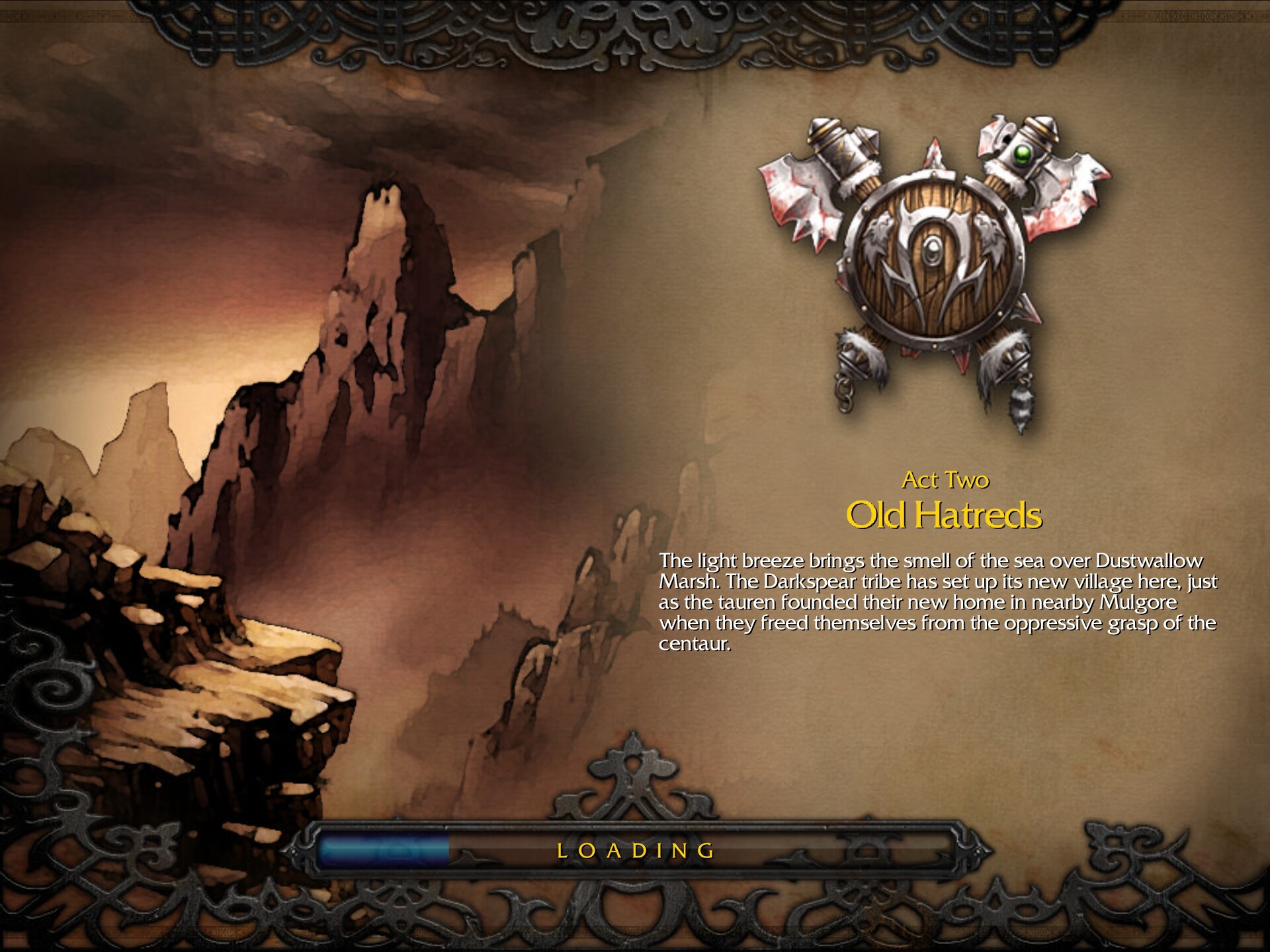
Our heroes have arrived in the new troll camp in Dustwallow Marsh, which, unfortunately, is represented by the Barrens tileset, just like Durotar.
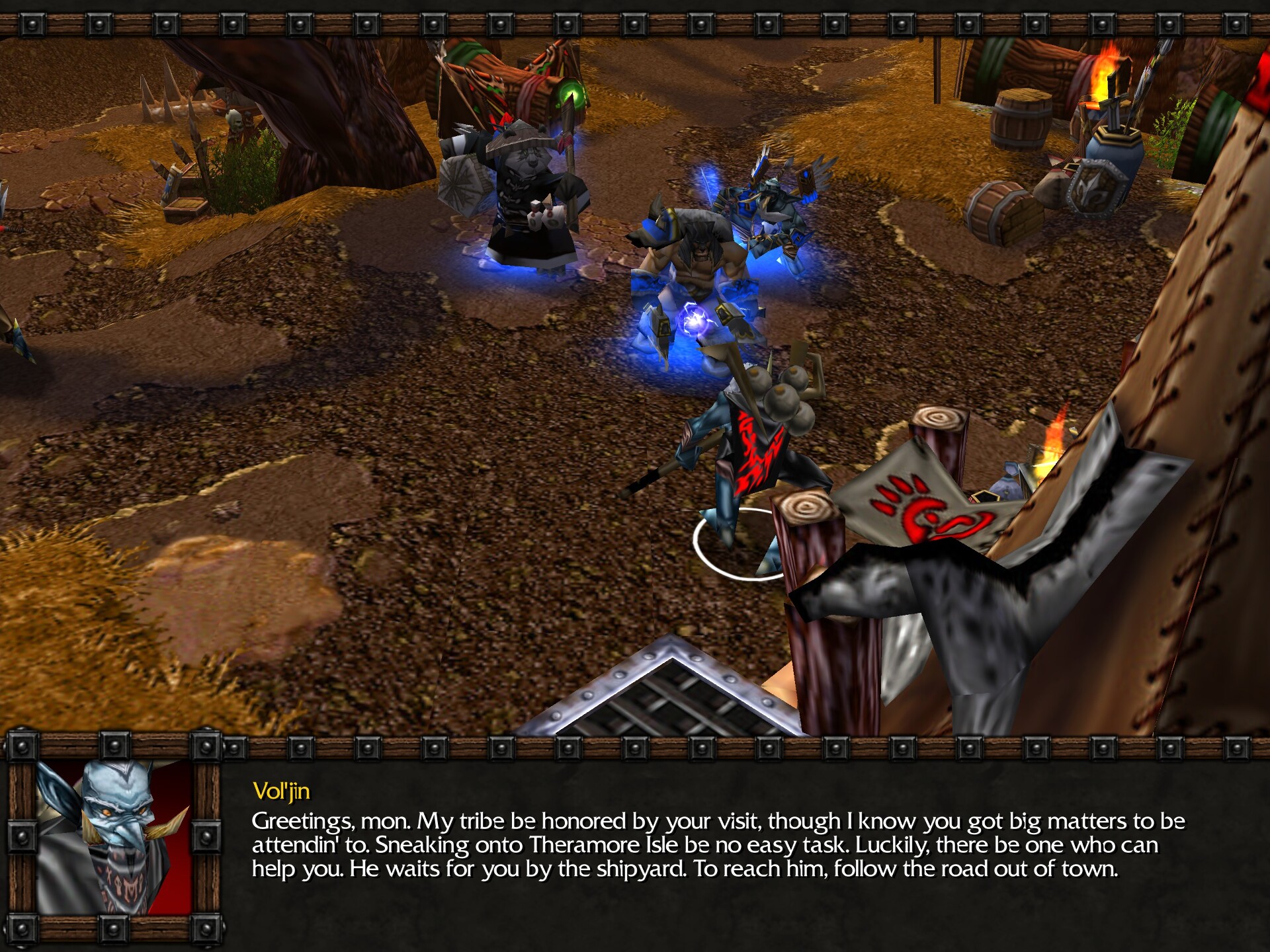
We’re supposed to sneak into Theramore Isle, but there’s a large human base in the way. To let us get past it, Vol’jin sends us to an expert in stealth, blademaster Samuro.
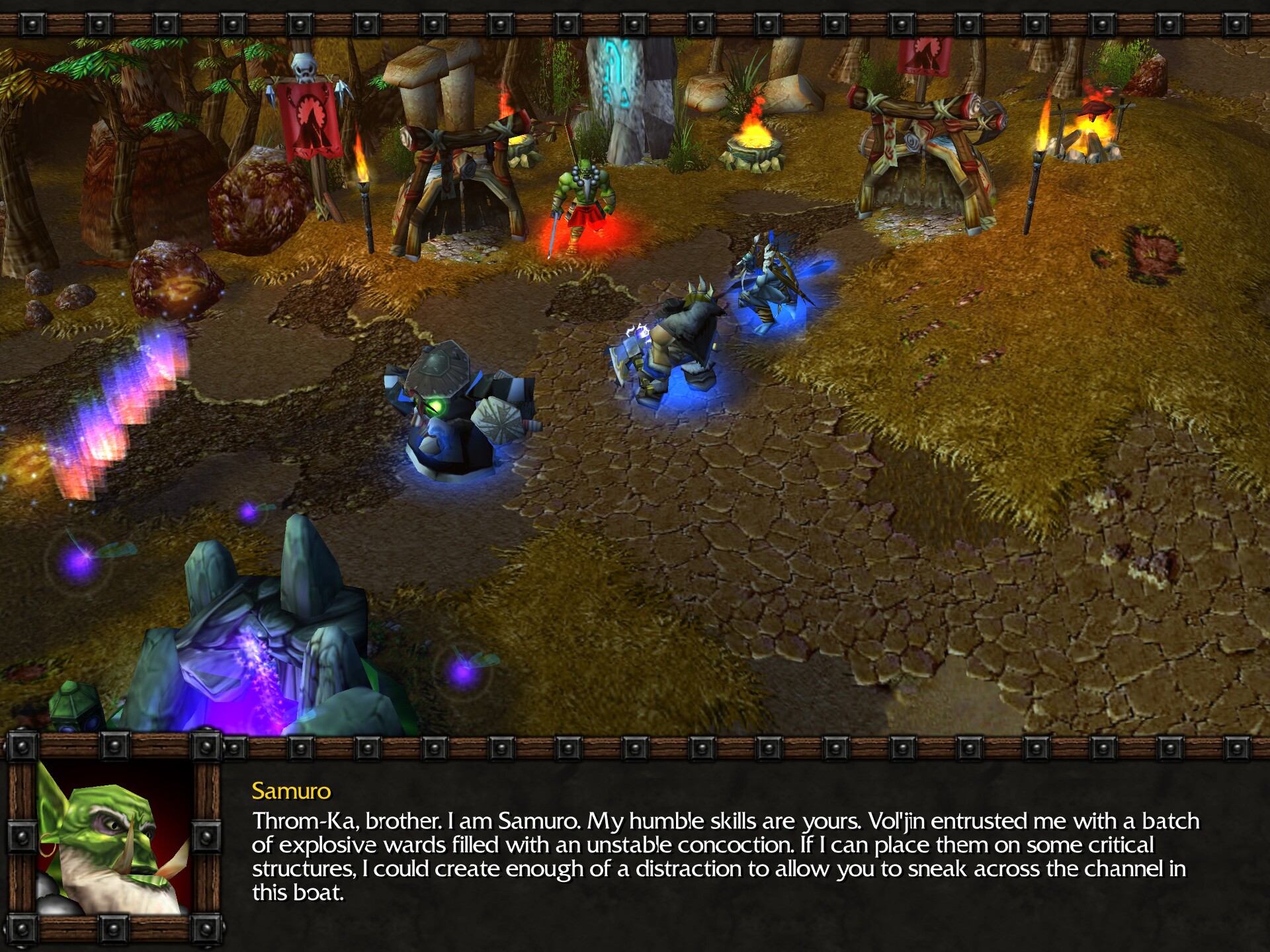
For this quest, we switch heroes. Rexxar, Rokhan and Chen stay at the zone border while we control Samuro only. He has a side quest to kill a wildkin boss, but his main purpose is to place five unstable concoctions throughout the human base, so that the resulting explosion will serve as a distraction.
This is easy. We activate Wind Walk, which makes Samuro invisible, and just run from one designated demolition site to another, sometimes stopping at towers to blow up conveniently placed explosive barrels around them.
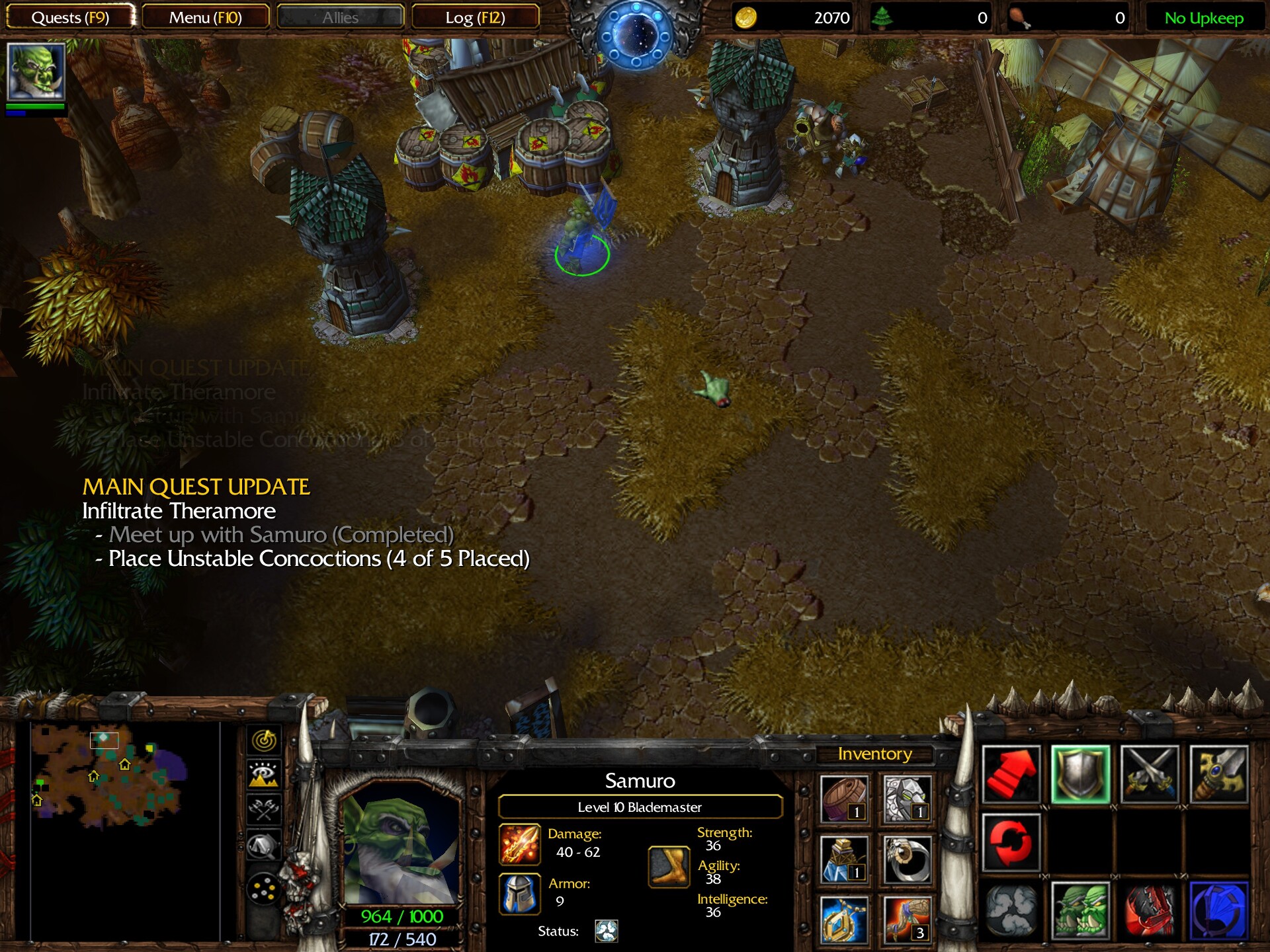
As the base is rocked by explosions, our heroes take a transport ship1 to Theramore, where they find Jaina, and nobody tries to stop them.
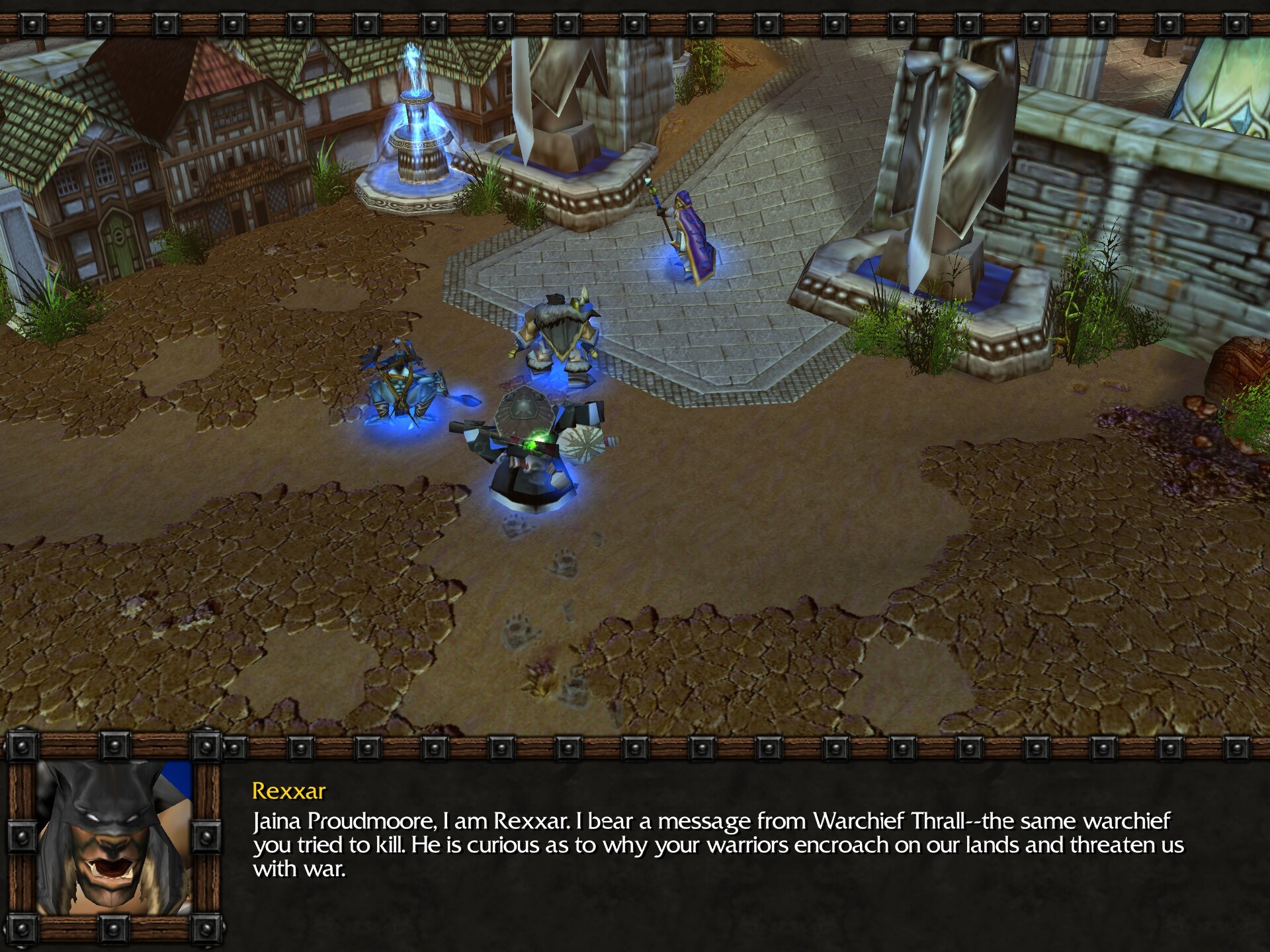
Jaina denies having anything to do with the attacks on Durotar. She doesn’t seek Thrall’s death, nor does she have any intention of betraying their pact. She asks Rexxar to lead her to these hostile troops so she can see for herself.
However, when we get back to the camp, we find that it’s been destroyed by naga!
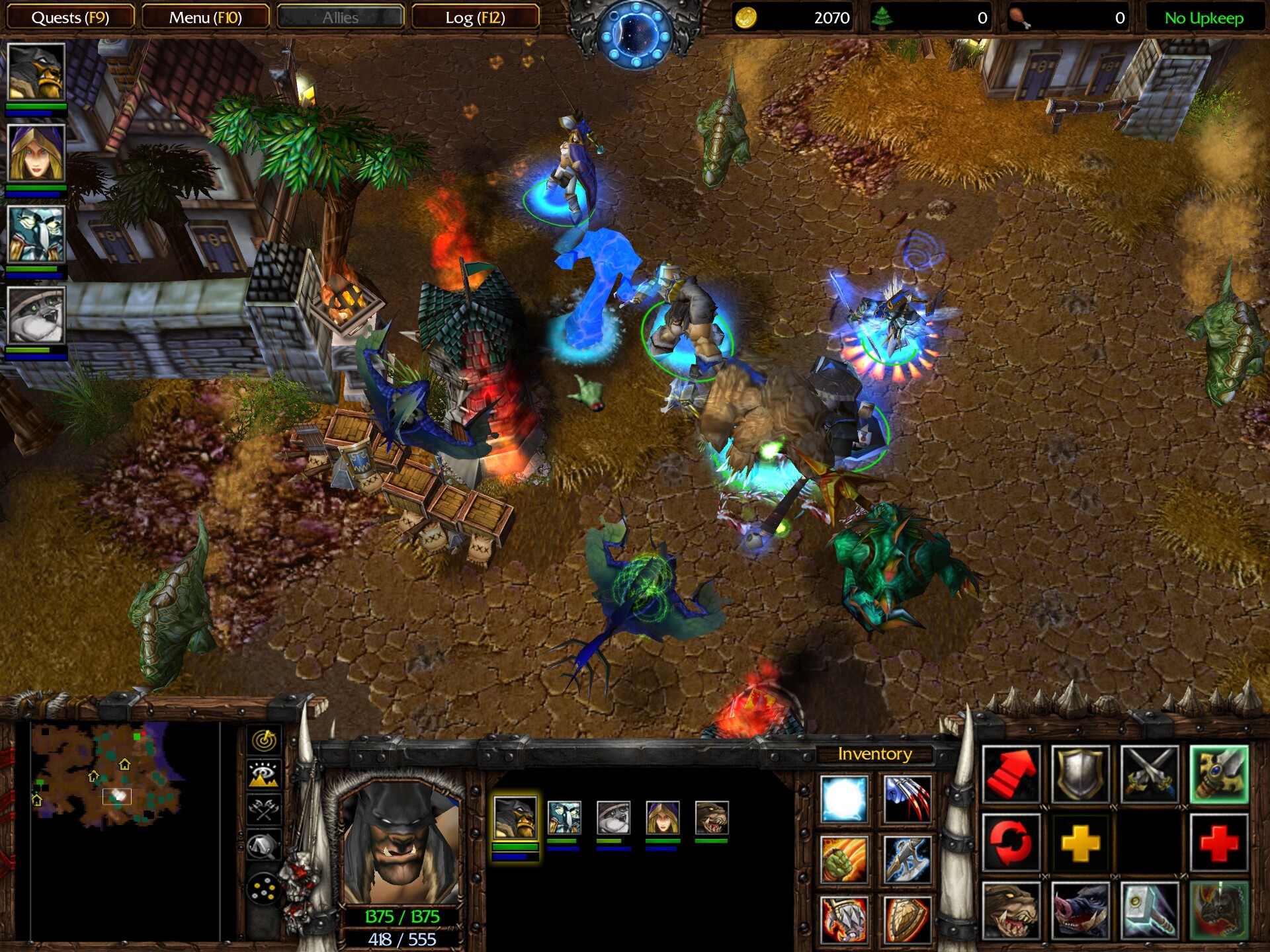
We get Jaina as a temporary party member, as if an apology for only letting us control her for two missions back in the human campaign. She’s level 10 and thus has her ultimate ability, Mass Teleport, only it’s useless here because there are no friendly buildings on this map, nor friendly units other than the heroes. Sigh.
Since there’s nobody left at the ruined camp, our only option now is to fight our way through the naga to their camp and hope we’ll find some survivors there. And that’s what we do, fighting through waves upon waves of naga through the entire southern portion of the map. Some of these fights, especially those with royal guards, are pretty hard.
At the camp, we find that most of the human captives are already dead, except for a single mortally wounded footman — who recognizes Jaina.
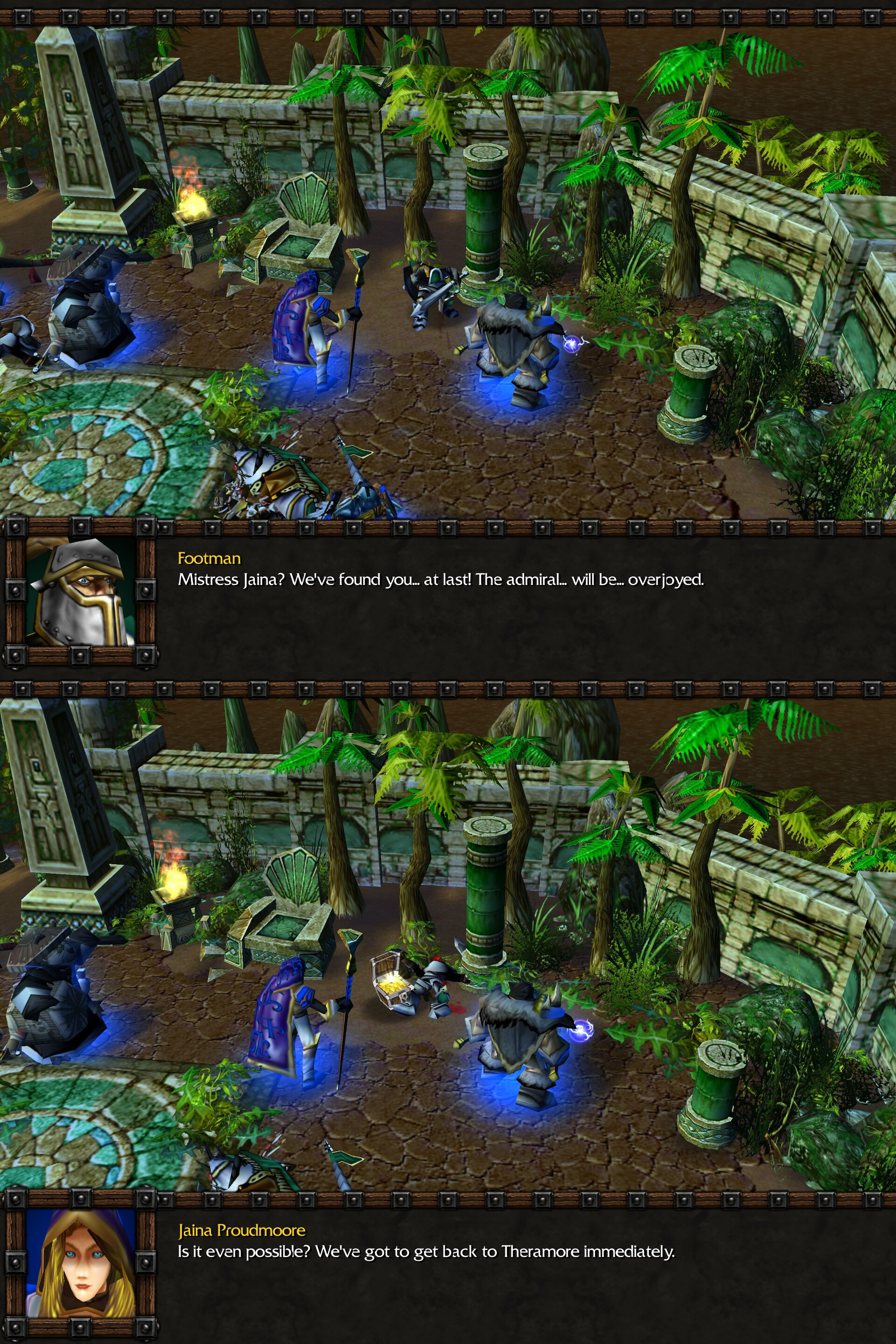
Rexxar asks what this is all about, and Jaina says she’ll explain when they return.
Escape from Theramore
Back at Theramore, a fleet of warships sails through the canals. Its leader disembarks and turns out to be none other than…
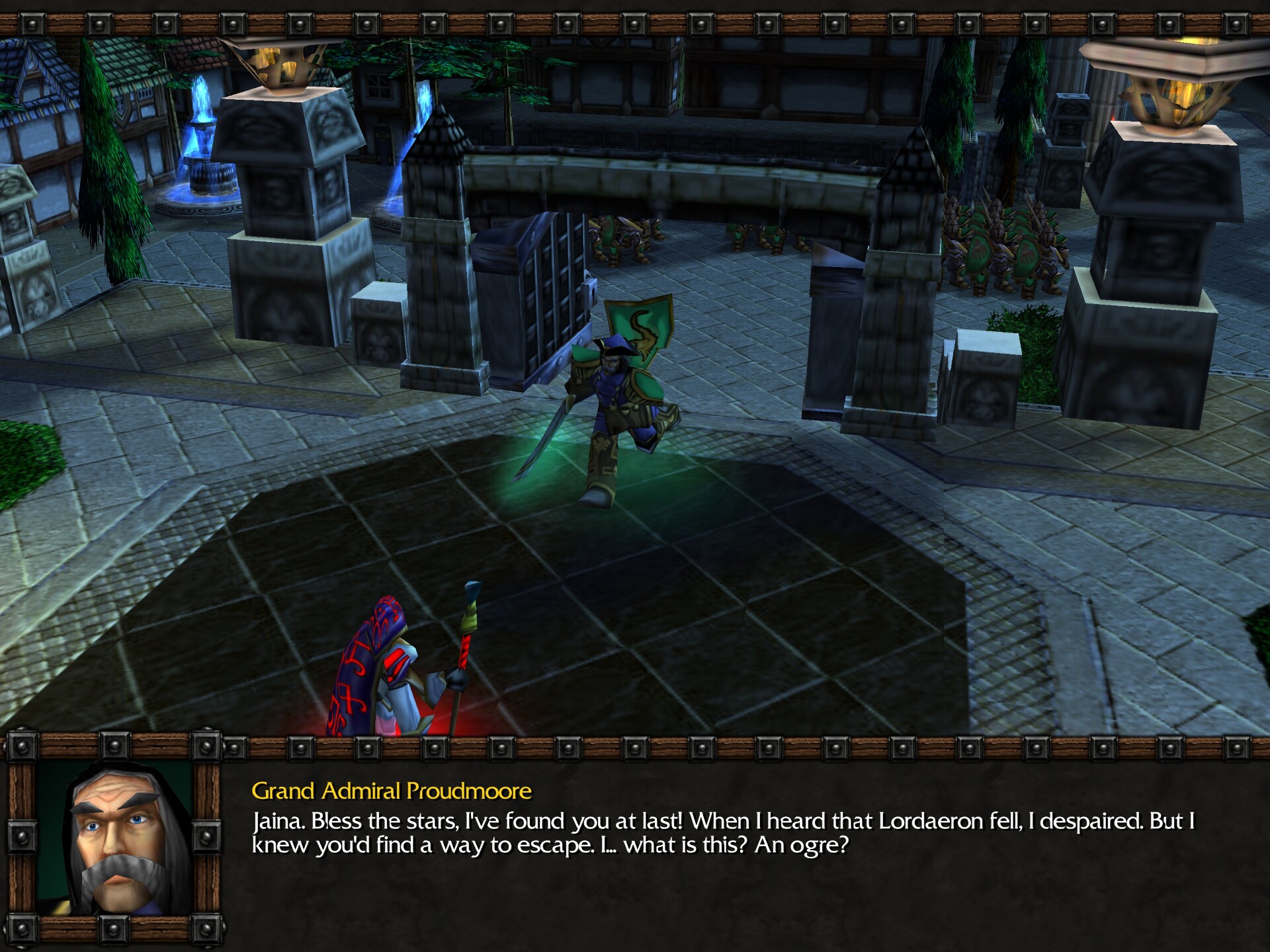
…That guy from the Warcraft 2 manual! Daelin Proudmoore, Lord Admiral of Kul Tiras, and coincidentally, Jaina’s father. He immediately takes issue at Rexxar being present, and though Jaina tries to plead with him that the Horde is no longer their enemy, he’s not having any of it. After the orcs and their kin ravaged their homeland, he believes that they must all be exterminated like the mongrels they are.
He leaves, telling his soldiers to seize everyone present. Jaina, instead of joining us, simply… teleports away. Well, drat, thanks for nothing. You couldn’t have taken us with you? You’re a level 10 archmage with Mass Teleport, hello?
Now that Theramore has fallen under Daelin’s control, we have to escape. Thus begins… what I personally consider the most boring quest in this entire act.
As an island, Theramore can only be entered and left by sea. We find a transport ship easily enough, but now we have to navigate it through the canals.
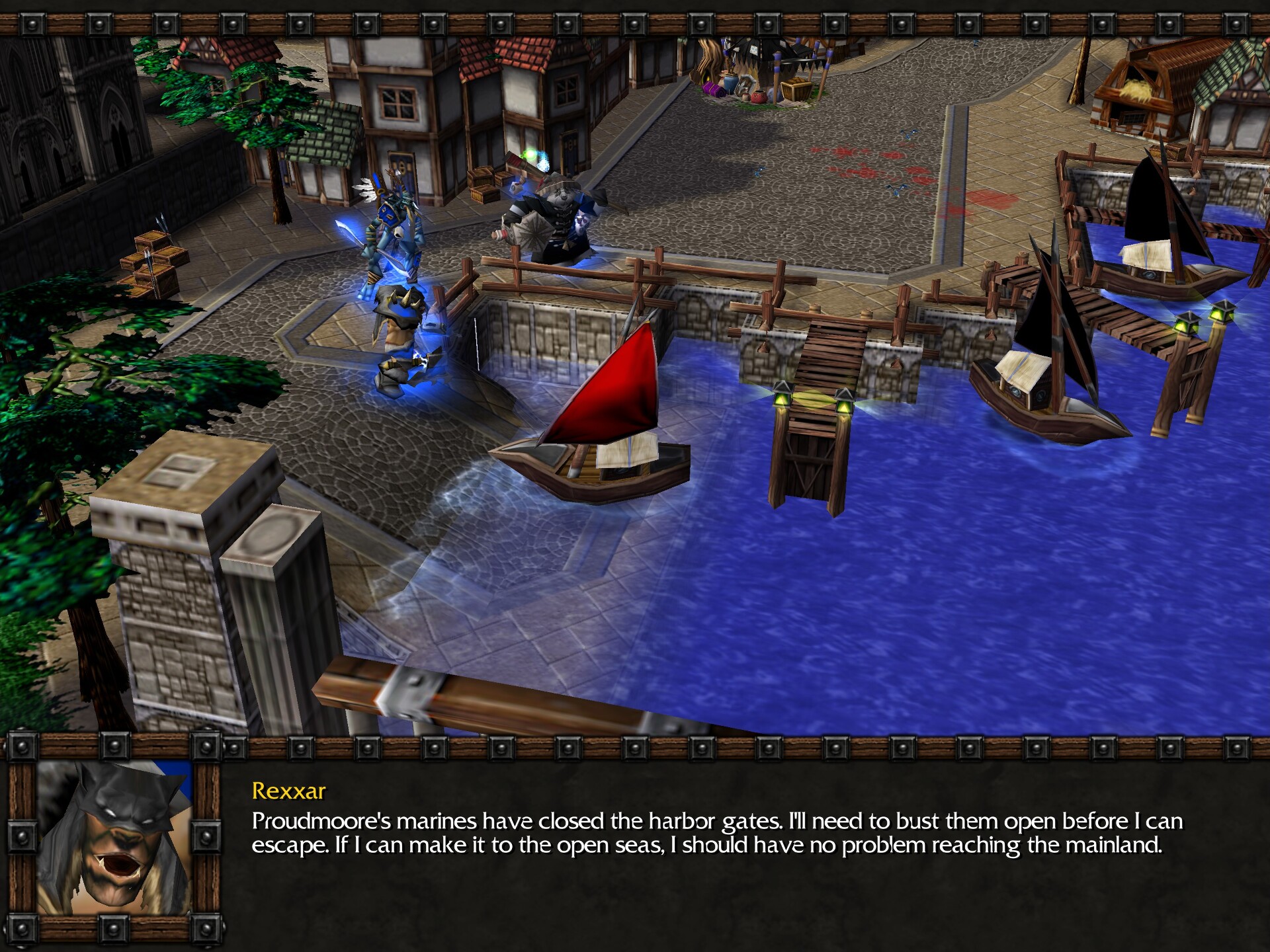
The canal winds around the entire map in an arc and is blocked by five2 gates that need to be opened from land. This means that we constantly have to disembark the ship, kill whatever units are protecting the next pressure plate that opens the next gate, and climb aboard again. And the closer to the exit, the tougher the fights get. Though the Kul Tiran troops reuse the models of regular human units, they’re actually tough elites. How about six elite priests who constantly chain-heal each other, plus a paladin who resurrects them all unless he’s killed first? The final fight consists of these guys, who are all elite:
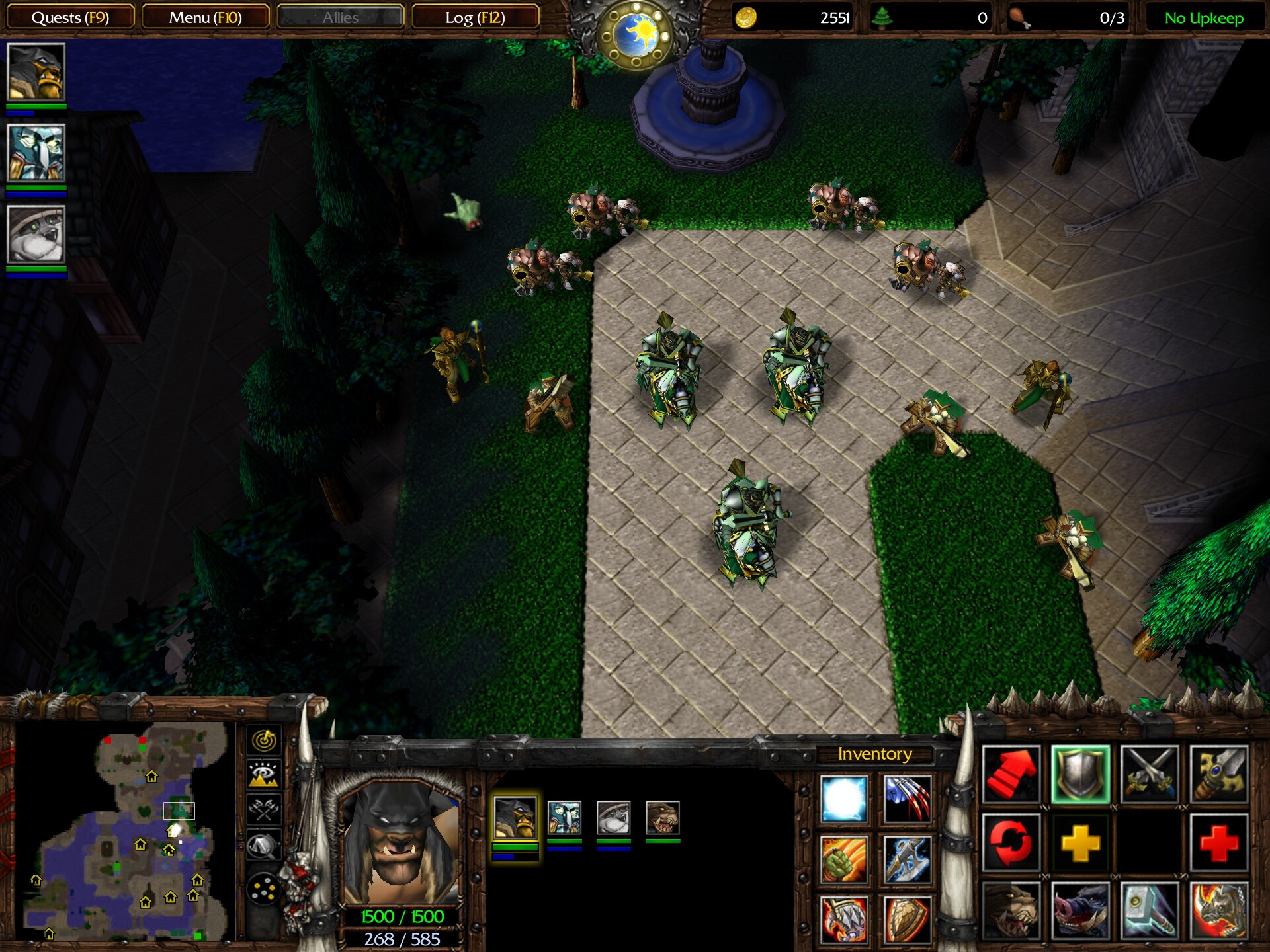
That alone would have been bad enough, but when you attack them, they’re joined by a level 12 archmage, mountain king, and paladin, whereas our own heroes are only level 8 by now. It took me multiple tries and blowing all cooldowns to get past this point.
Still, we leave Theramore behind. Back at the troll camp, Vol’jin charges us with gathering whatever allies of the Horde we can find, starting with the tauren of Mulgore.
Enlisting the Tauren
Mulgore is a separate map, which uses… you guessed it, the Barrens tileset. We find Cairne easily, but he’s not going to offer his help: he’s grieving and asks us to tell the warchief that “I am dead… just as my heart is dead”.
Thankfully, another tauren steps in and explains what the problem is:

There’s also yet another genocide side quest, as local harpies have been preying on the tauren’s kodos and the quest giver wants them all dead, down to the last one. What is it with Horde nations and genocide? The main quest, meanwhile, takes us to a spirit walker3 called Bovan Windtotem, who tracks Baine down to a cage in the centaur camp and joins our party alongside his fellow spirit walkers.
We fight our way through and rescue Baine, who looks like a miniature Cairne.
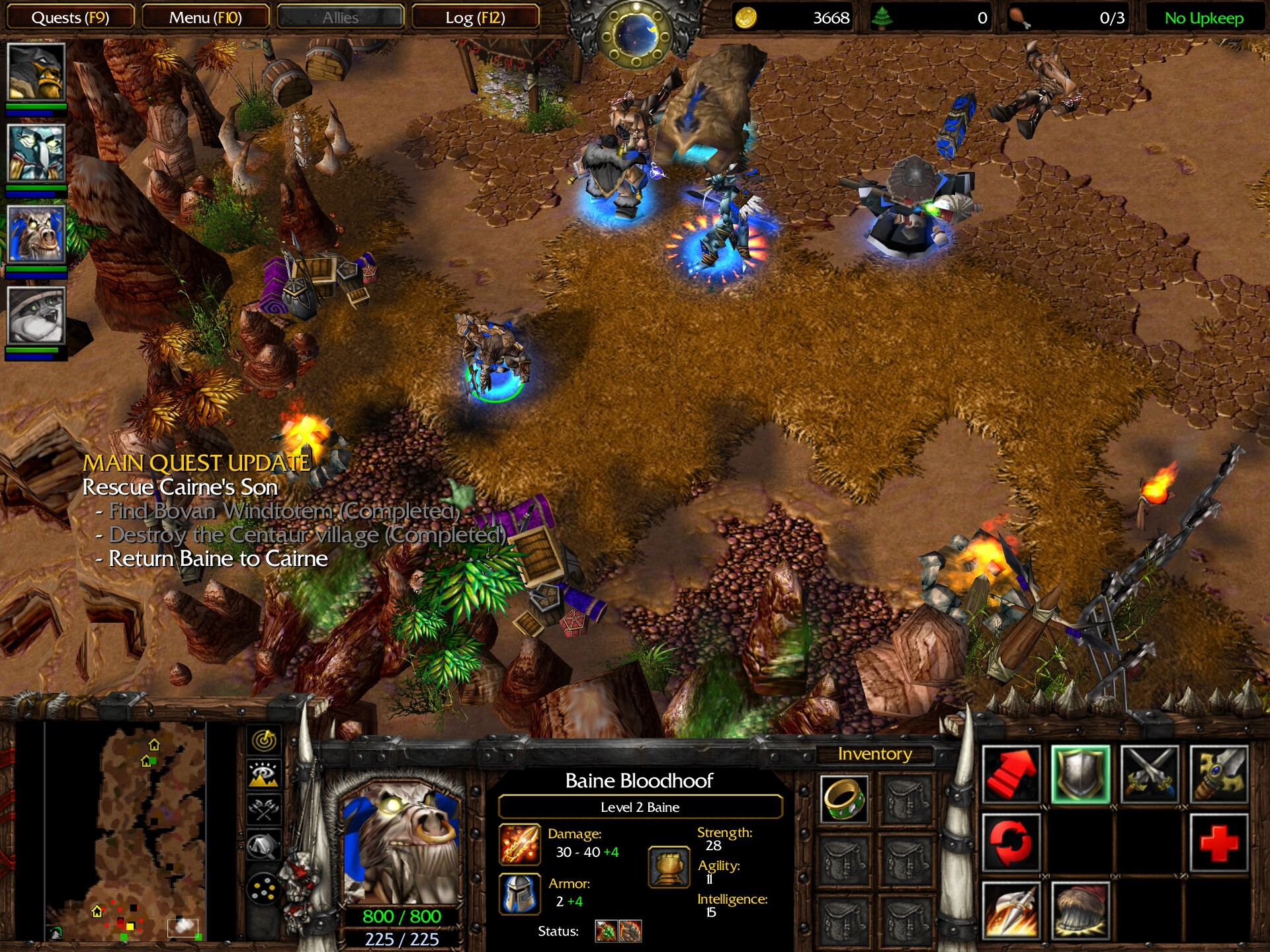
Now that we killed all the centaurs to get here, it’s only logical that the return path shouldn’t be difficult, right? Wrong! Somehow, while we were freeing Baine, all the centaurs in the valley we had marched through have respawned, and we have to kill them again on the way back.
Cairne is overjoyed to have his son back, and Baine leaves our party… to be replaced by Cairne himself! He will send his warriors to the warchief, but he himself will adventure with us as a very welcome fourth hero, a level 10 tauren chieftain.
Enlisting the Ogres
When we get back to Vol’jin, he has some company in the form of a wounded ogre:
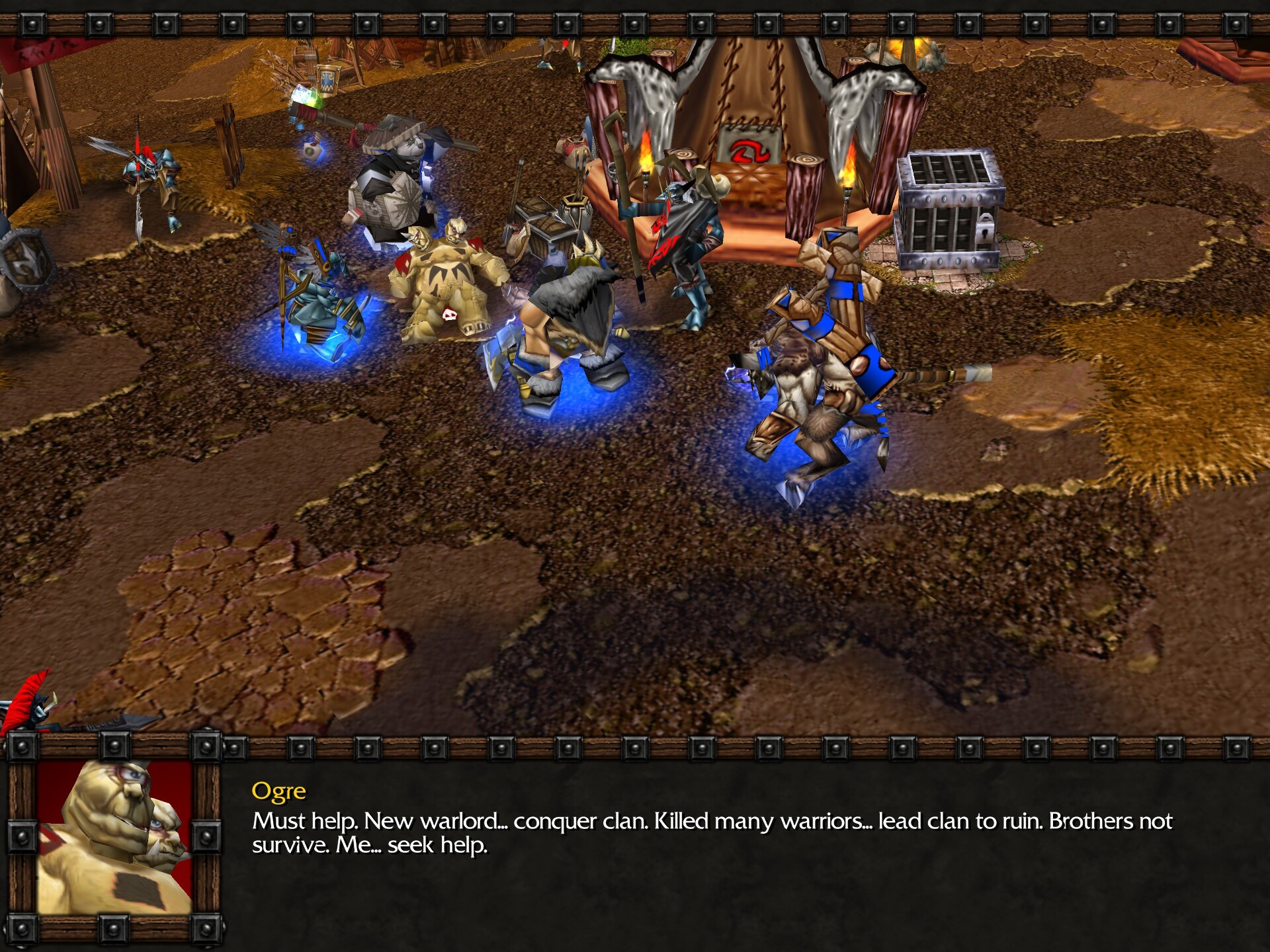
Rexxar decides to pay a visit to the ogre clan and meet this new warlord for himself.
Once we reach the ogre village, we have to fight through some cocky guards who won’t let us past. The chief approves of Rexxar’s fighting skills and asks the “halfbreed” why he came here. His response?
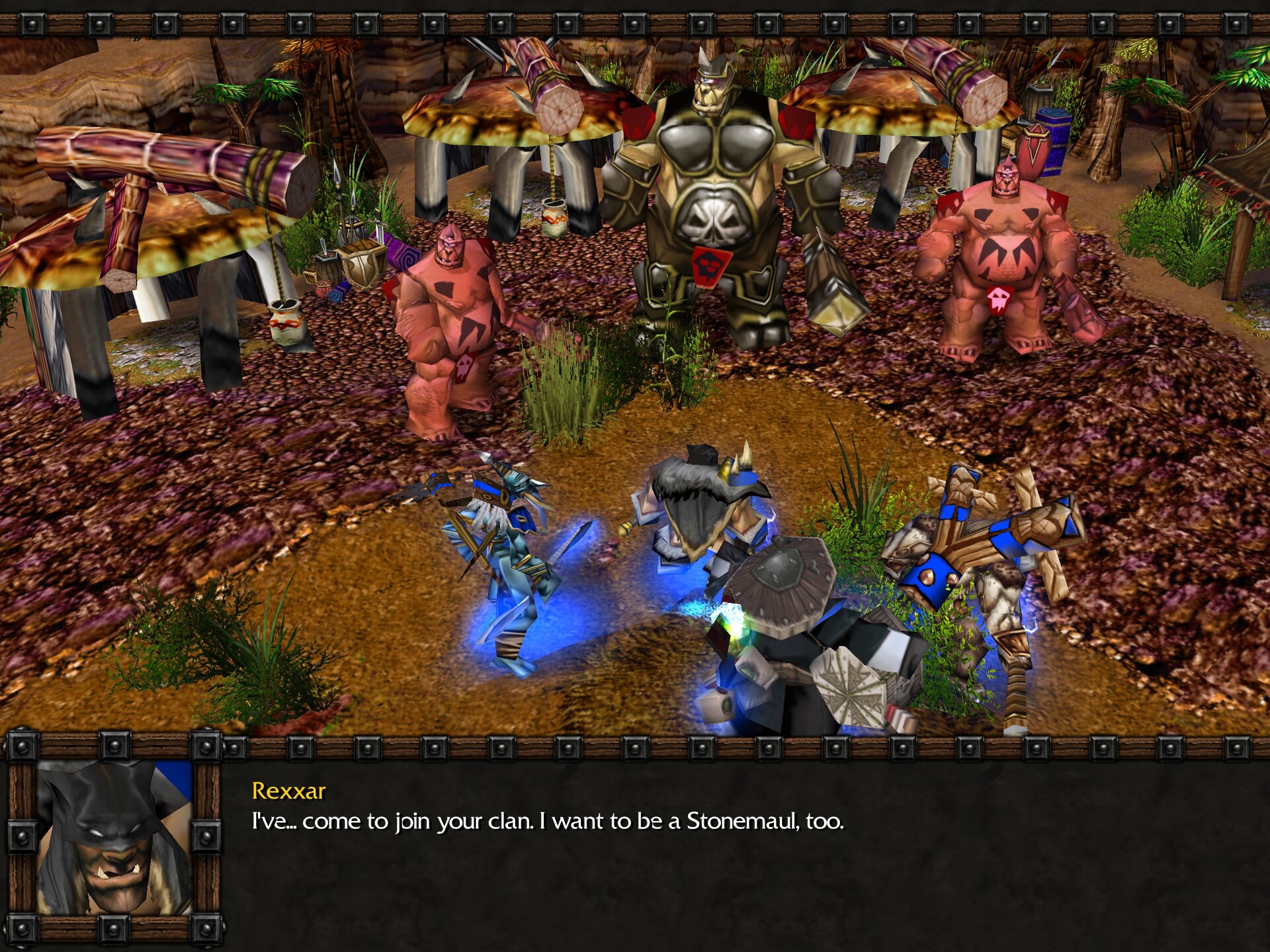
As he has some ogre blood, the chief, Kor’gall, says he has the right to join, but first he will have to prove his worth. And the way to do it is by entering the nearby valley, ominously named “the Gauntlet”, and killing each and every creature within it. We get yet another “creatures left” counter, and wow, this valley is kind of overcrowded:
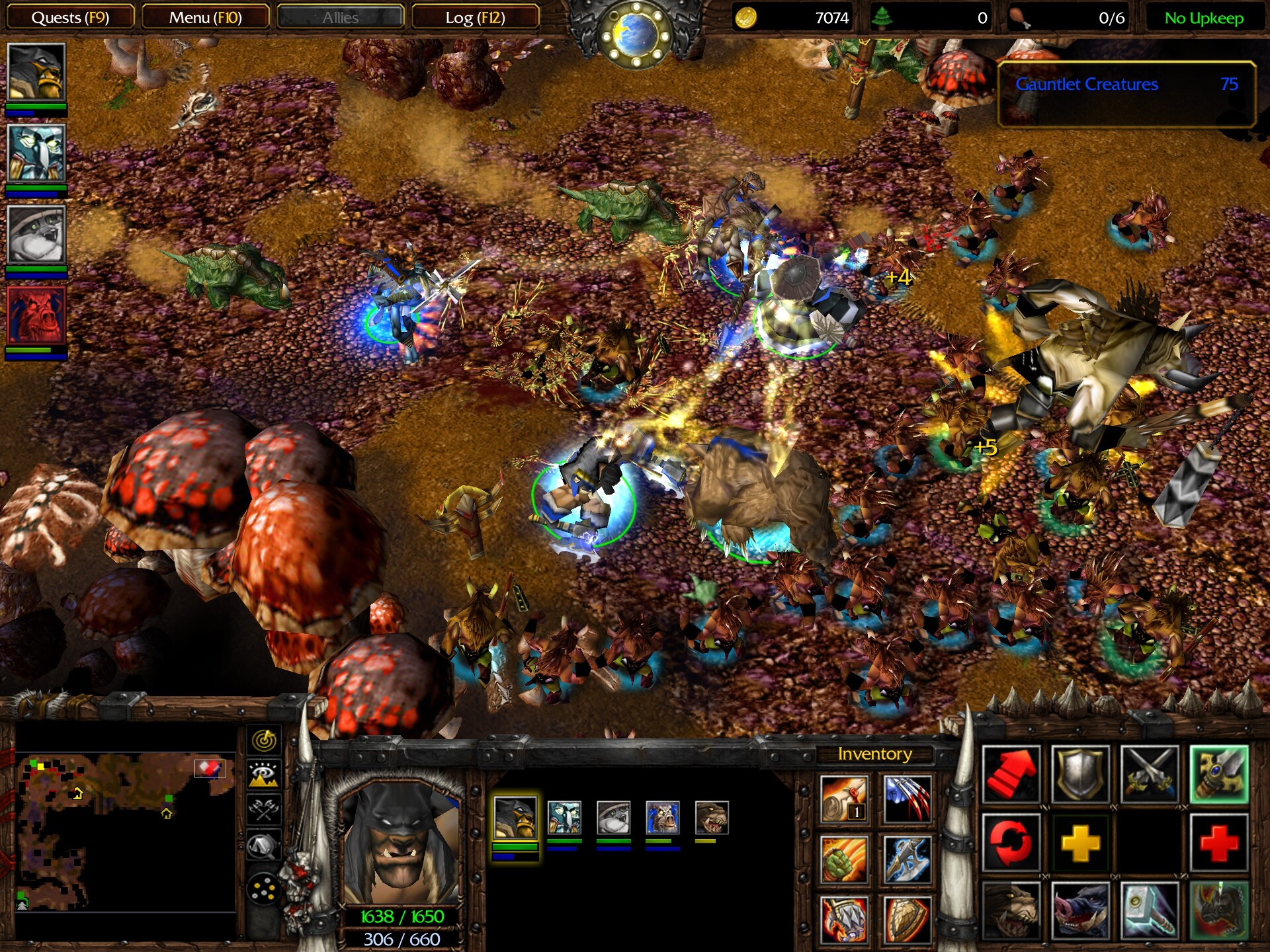
We fight our way through quillboars, wildkin, and finally, thunder lizards. When the counter reaches 0, we return to Kor’gall, who inducts Rexxar into the Stonemaul clan and asks what he wants from them. Rexxar, earnestly, says he wants them to help the Horde in battle against humans, but Kor’gall laughs it off.
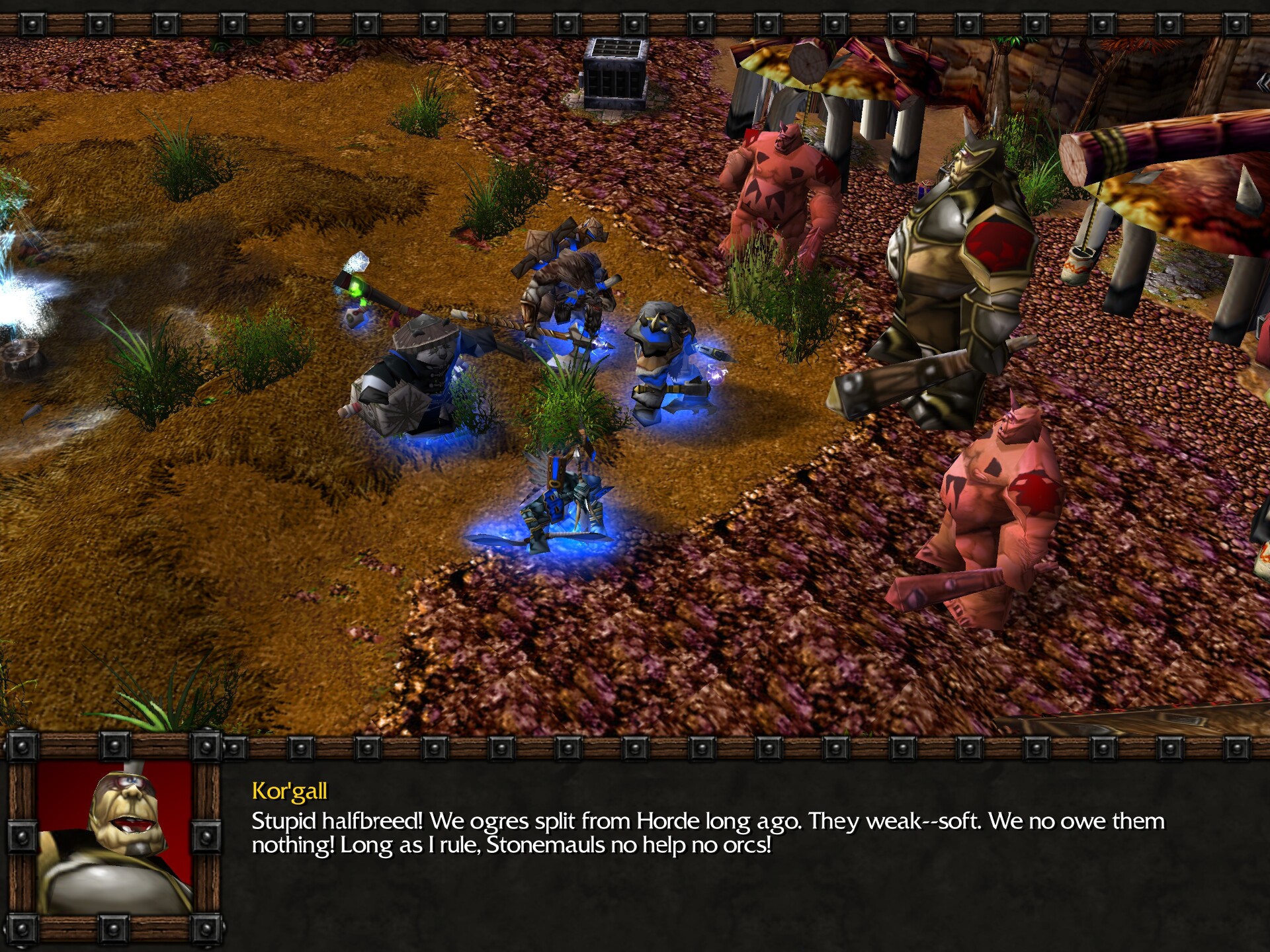
In response, as a member of the Stonemaul clan, Rexxar challenges Kor’gall for leadership. See, fantasy tribal chieftains? This is why you don’t allow adventurers with an agenda to join your tribes!
Rexxar is teleported to the arena, which takes the entire middle portion of this map. Kor’gall says that no magic tricks are allowed, so all of Rexxar’s items are taken away.
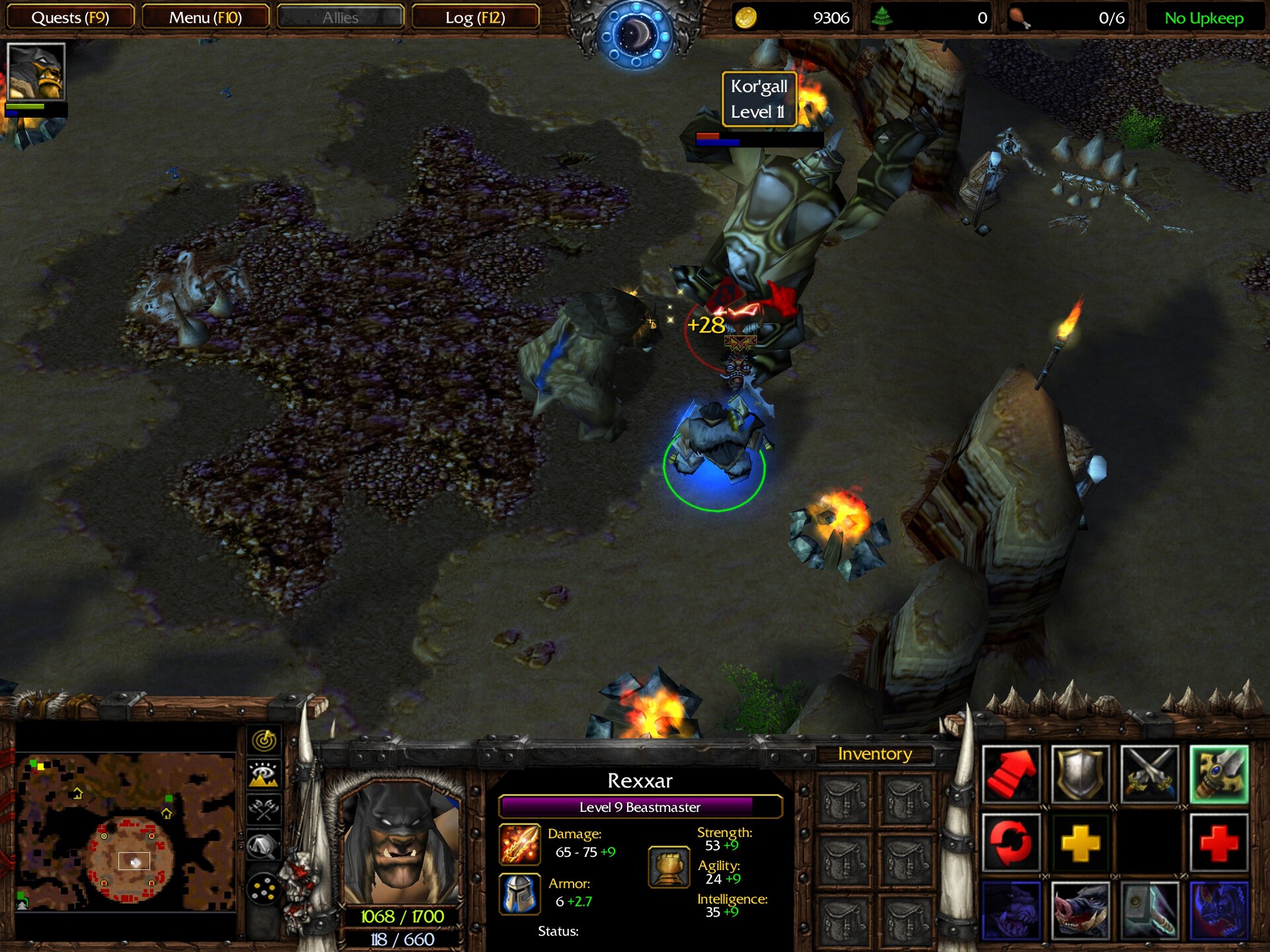
This is a tough fight, probably the second toughest in the campaign after the three Kul Tiran heroes and their plethora of troops. Kor’gall has 4000 HP and hits hard, so it’s best to have Misha tank him. There are runes of healing and mana scattered throughout the arena, which Kor’gall doesn’t use (leaving Rexxar free to use them), but Kor’gall constantly drops serpent wards and, more annoyingly, healing wards, which must be destroyed immediately to prevent him from healing the damage we deal. Eventually, he falls, and Rexxar is proclaimed the new clan leader.
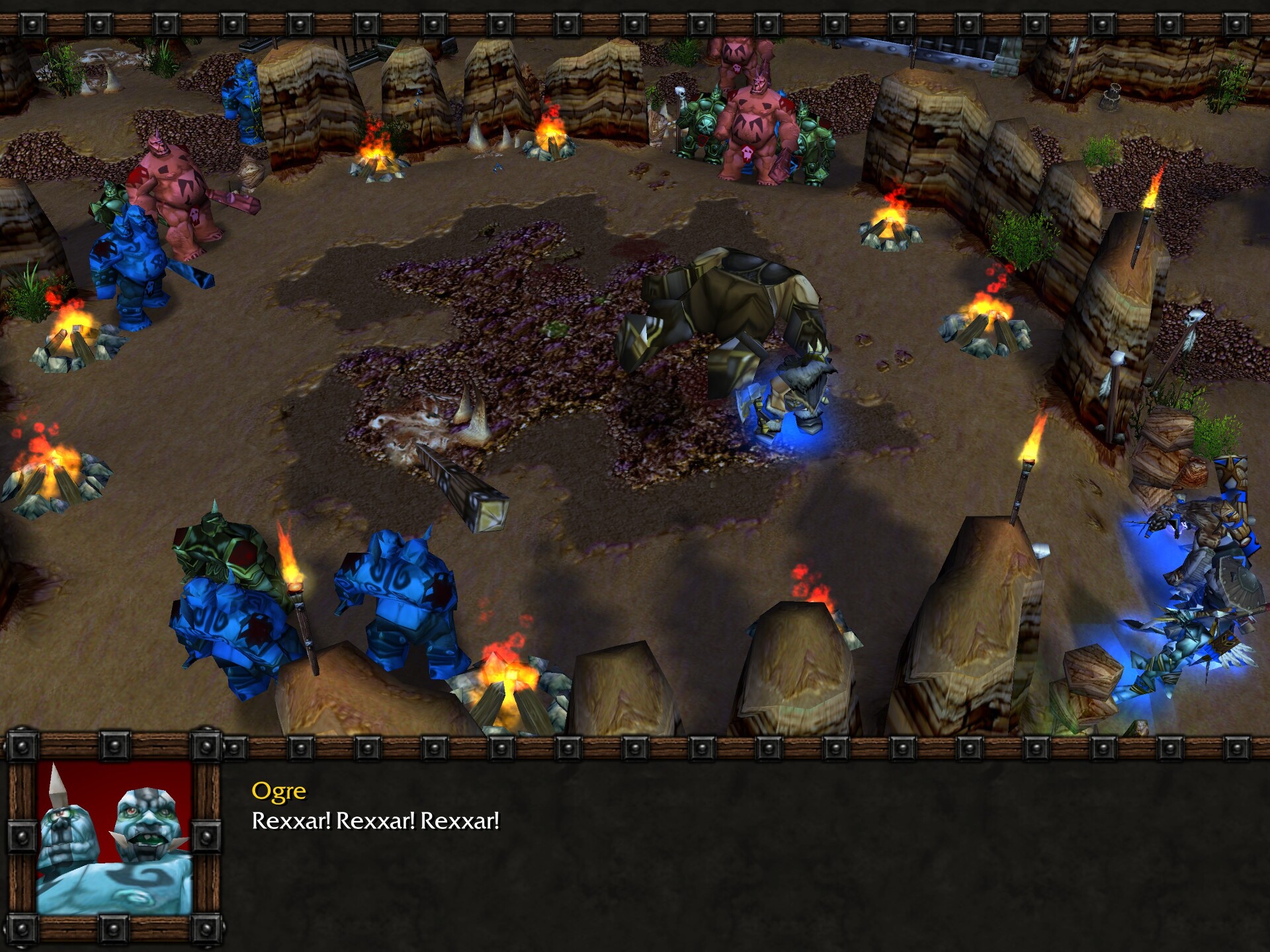
And as the leader, the first thing he does is call the ogres to war, commanding them to arm themselves and meet the orc warchief upon the plains.
Tidefury Cove
Everything is ready to begin the assault. Vol’jin tells us to check with Thrall at the forward base, and Thrall entrusts us with one last side quest before the act finale: to assemble three rare ingredients for the new banner bearing the symbol of the Horde. This is easy enough, but annoyingly, when we return to the base, Thrall isn’t there. Instead we have to turn in this quest at another map entirely, at the forward forward base.
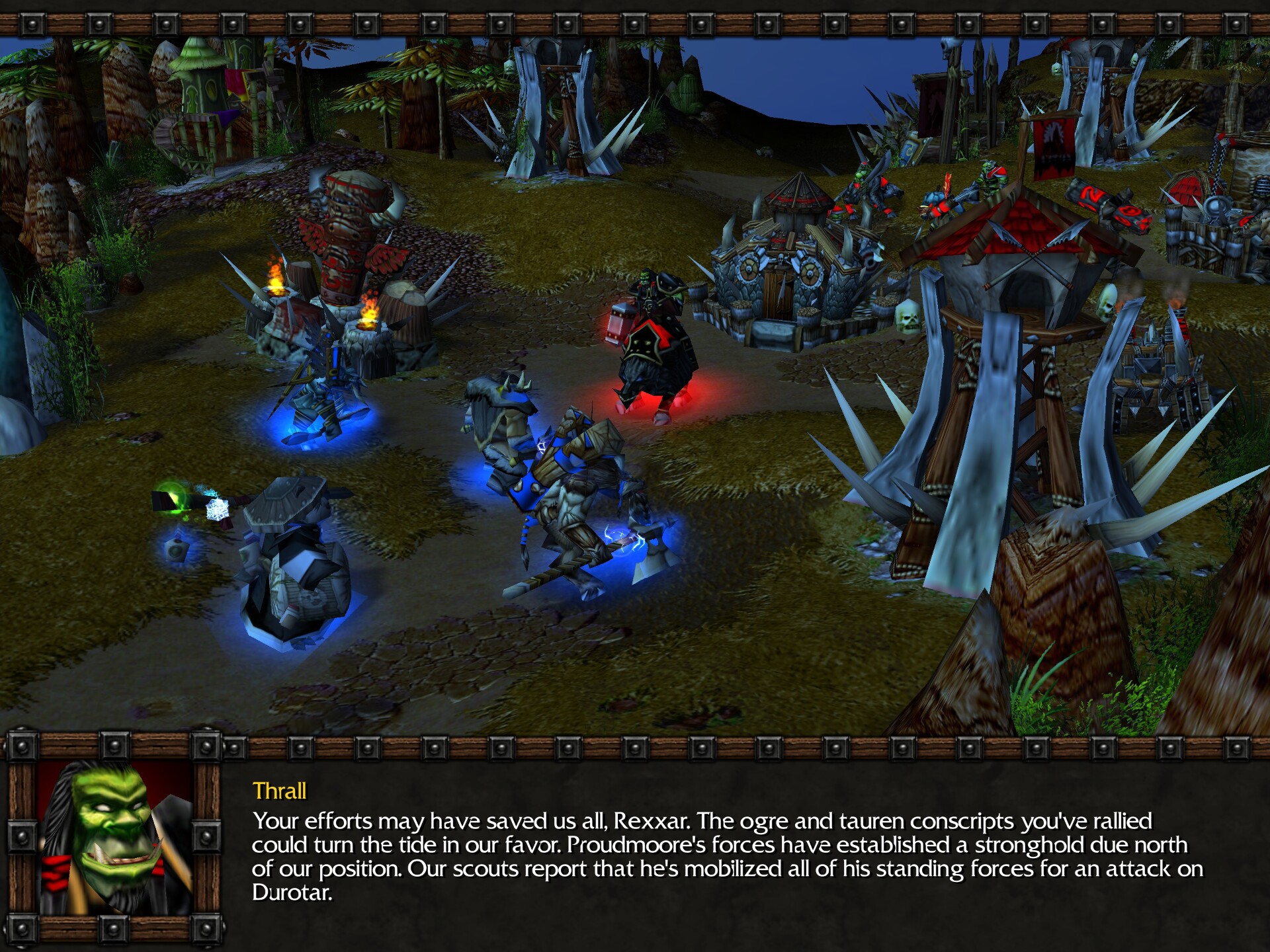
Before we can assault Theramore itself, we first need to destroy the large human base here, in Tidefury Cove. And wow, this turns out to be harder than I expected. I don’t know if it’s a scripting bug introduced in one of the patches, because I remember this quest being easier at release, but the moment we reach the guard towers, the humans throw absolutely everything at us:
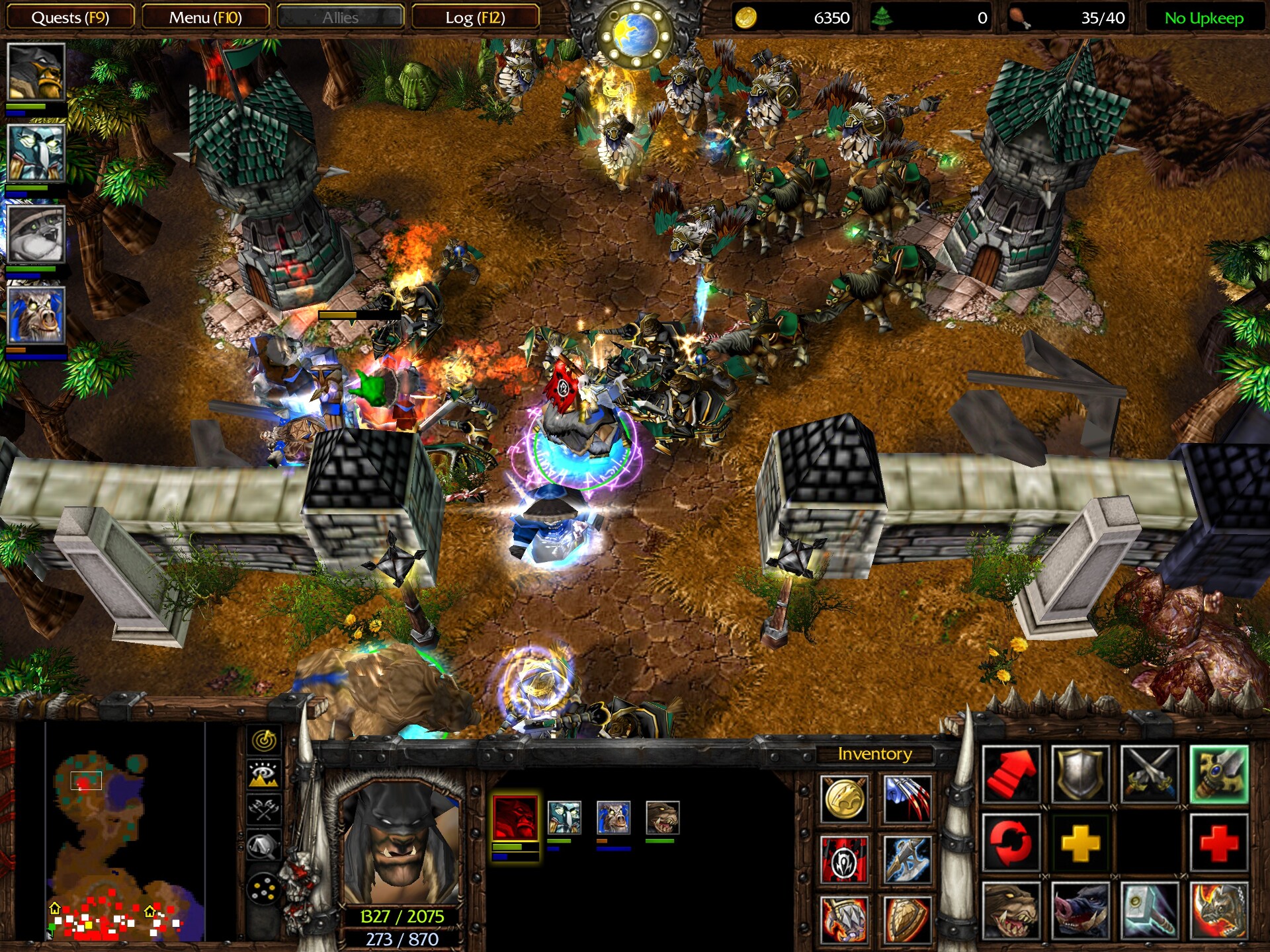
Footmen, riflemen, knights, hydromancers, gryphon riders, and Admiral Proudmoore himself, a level 15 hero — it’s all there. Trying to storm the base with just our heroes, no matter how powerful, is suicidal. Thankfully, for this quest alone, we also have access to a wide assortment of regular units — orcs, trolls, tauren, and ogres. They cost no gold to build, but they count towards the 40 supply limit. Building by building, the human base falls.
Though the Horde is victorious here, Admiral Proudmoore is in another castle has pulled back to the safety of Theramore Isle. That’s where our path lies.
A Blaze of Glory
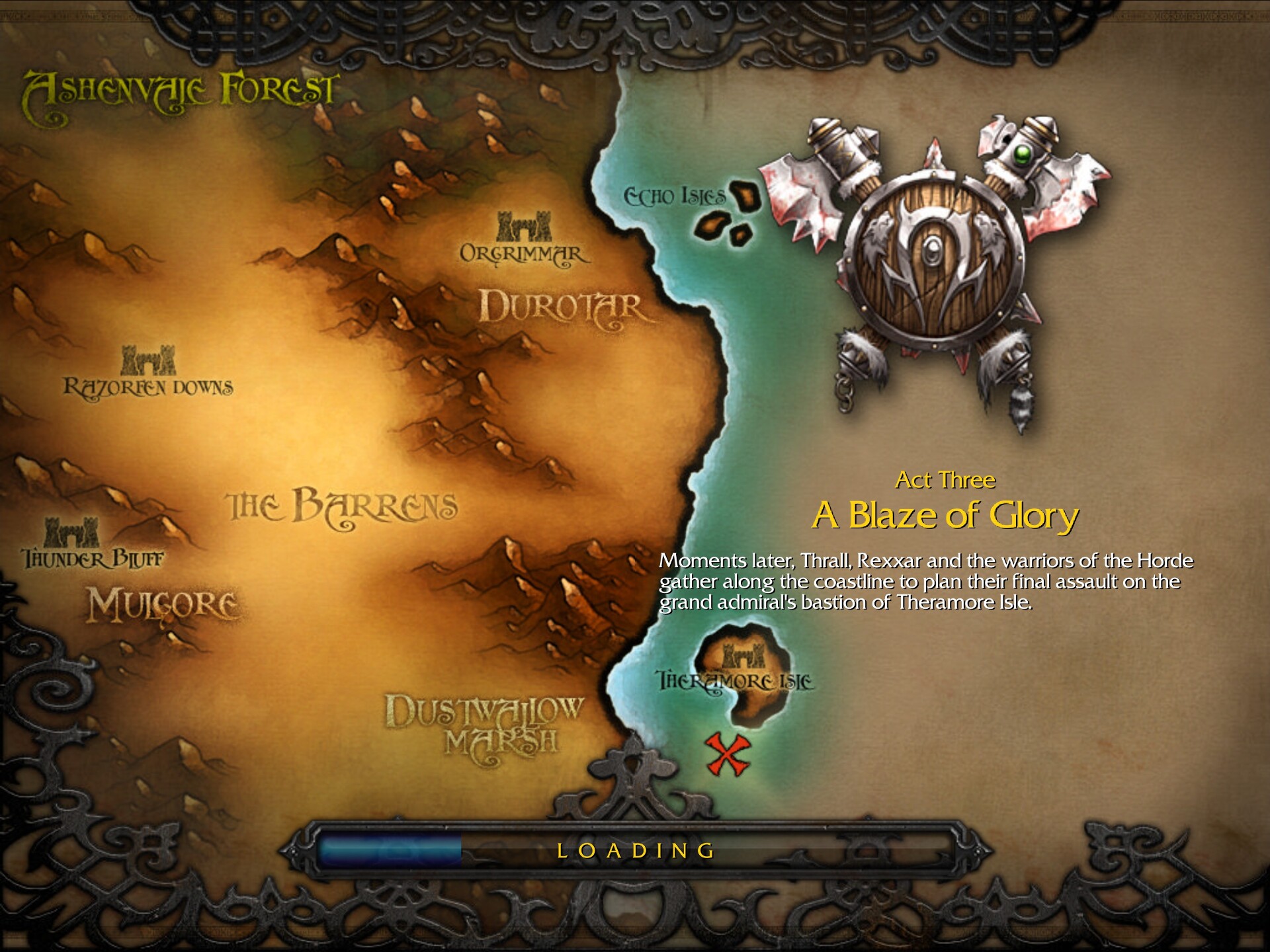
Compared to Acts 1 and 2, Act 3 is very, very short. I wonder if it’s because they ran out of budget or ideas, or it was planned like this all along. And frankly, I’m not sure Act 3 was even needed.
In the traditional three-act structure, the protagonists usually suffer a setback at the climax of Act 2, which they must then work to overcome in Act 3. This is difficult, however, to translate into video game format, where it is assumed that the player characters always win every encounter the game throws at them; after all, if they lost, it would be game over. A game where the protagonists never suffer setbacks is narratively unsatisfying; a game where the player wins an encounter only to have that victory undone in a cutscene is unsatisfying gameplay-wise. Knowing how to achieve the delicate balance between gameplay needs and story needs is part of the skill involved in writing a truly great video game.
Narratively speaking, we have already answered the question of “Are we stronger than Admiral Proudmoore?” at the climax of Act 2 by wrecking his base at Tidefury Cove, where he himself was present. Act 3 is thus entirely dedicated to defeating a guy we’ve already defeated, only for good this time. Maybe it would have been better to cut the Tidefury Cove quest entirely and instead transition from rallying allies straight to the siege of Theramore — which then could have been simply folded into Act 2 instead of making a separate, short Act 3.
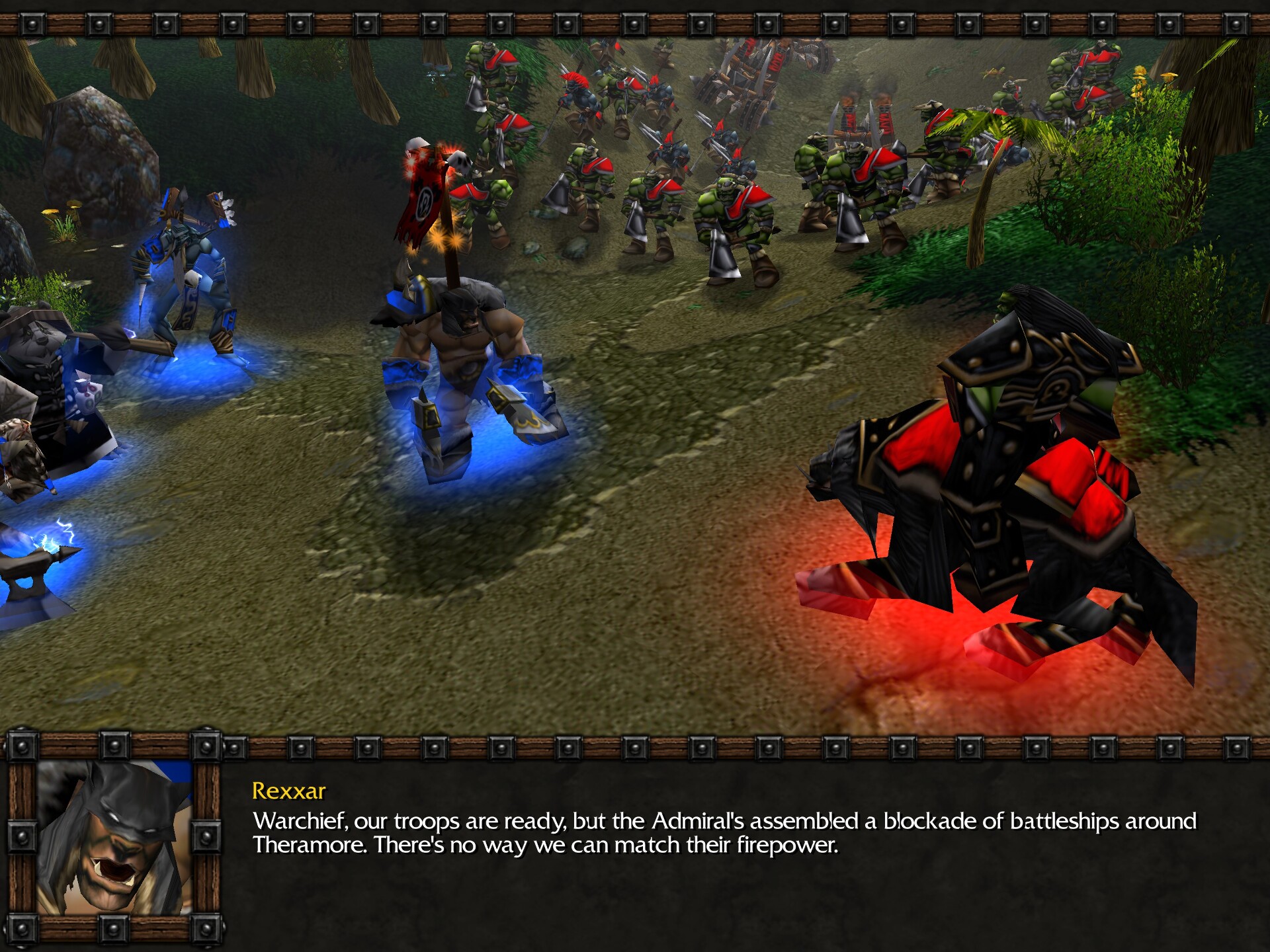
The Horde army is assembled and ready to besiege Theramore, but first, we’ll have to destroy the naval blockade around the island. And this task, of course, will fall to Rexxar and company.
Jaina won’t intervene herself, and asks Thrall to spare her men as much as possible, but she does tell us of a way to break the blockade.
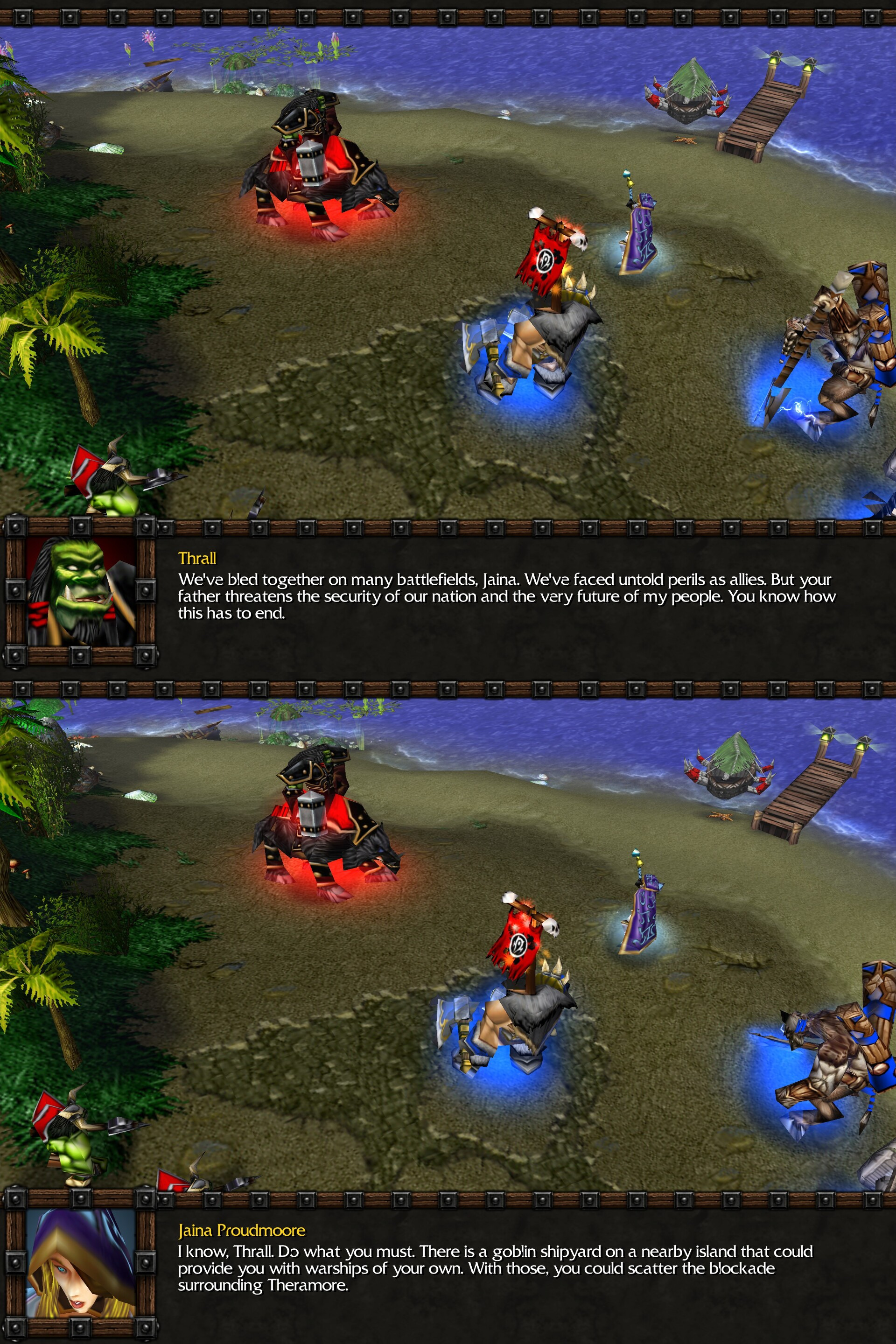
Mind you, this skirts dangerously close to treating gameplay abstractions as literally true. Ships are supposed to take an awful lot of time to build, but somehow this lone goblin shipyard can just churn them out non-stop? And match the naval might of Kul Tiras?
Following this unrealistic premise, we destroy the human base surrounding this goblin shipyard.
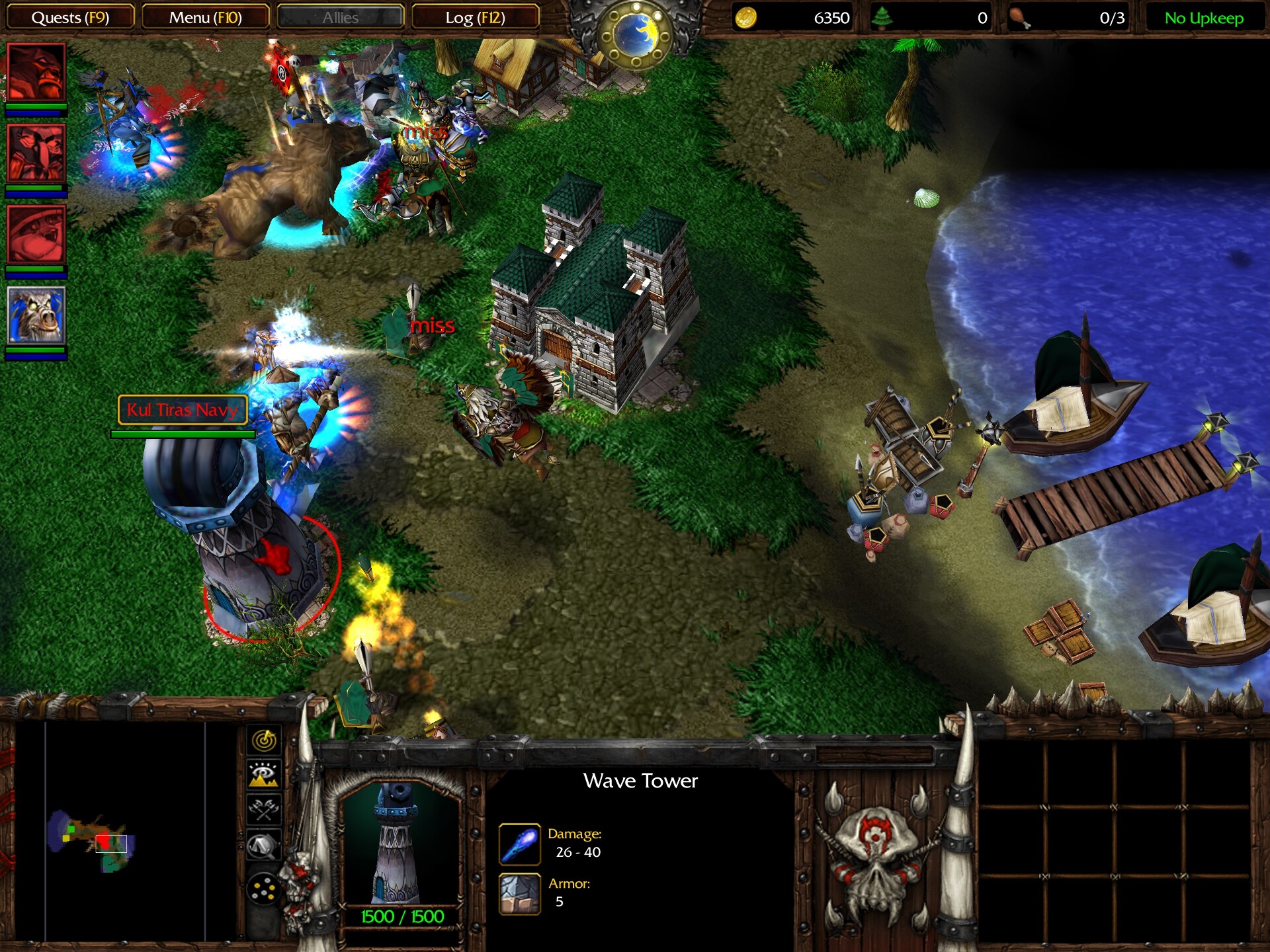
With the shipyard secured, we get an infinitely respawning supply of ships, with which we slowly whittle down the enemy fleet until we sink all six battleships.
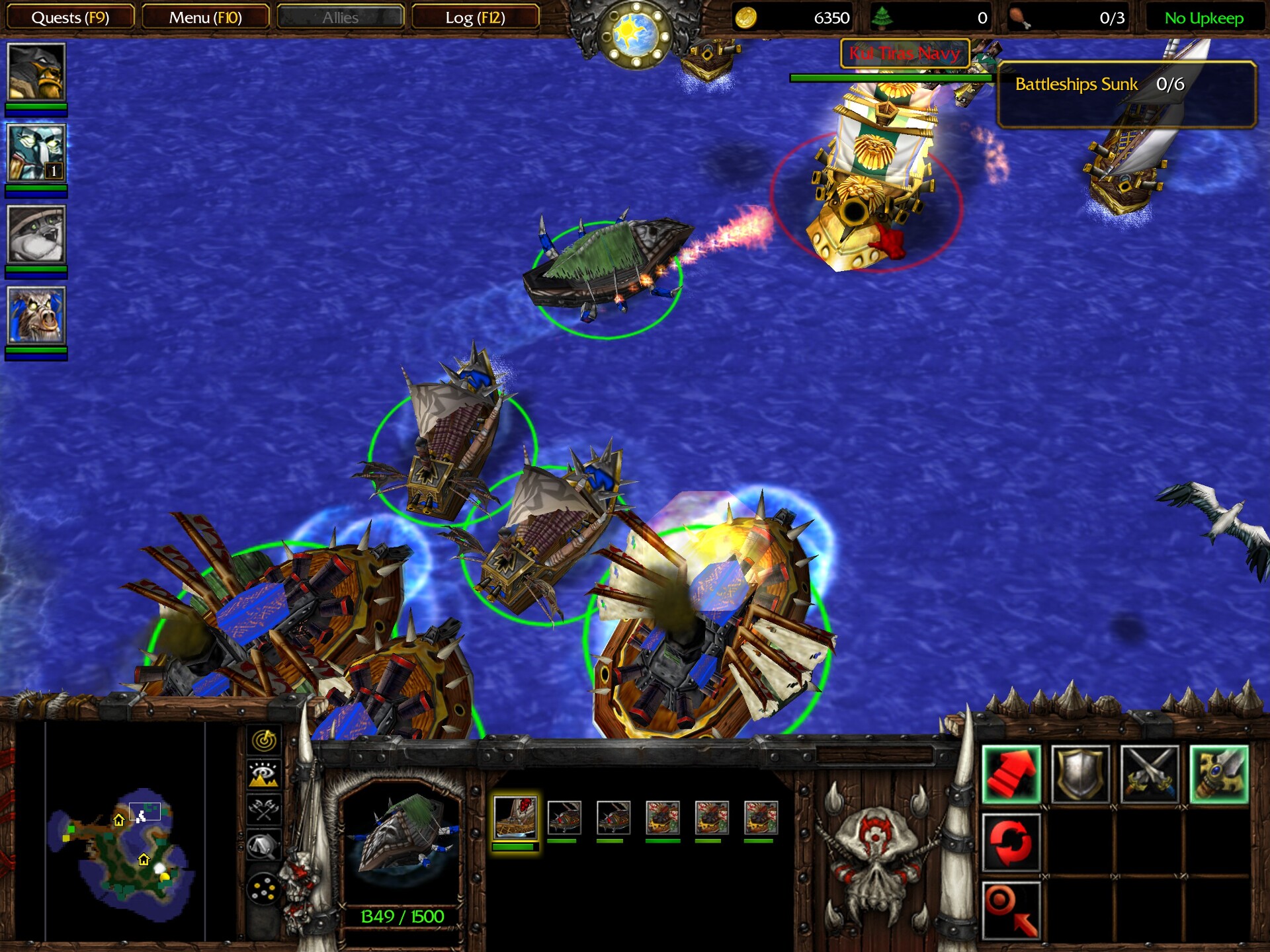
This quest is, of course, another nostalgic throwback to Warcraft 2. If this wasn’t obvious enough, the quest is named “Seas of Blood”, which was the name of the first act of the orc campaign in Tides of Darkness. Unfortunately, the implementation is—
They came from… behind!
…kind of a slog to play through.
The ships are surprisingly fragile, and the map is absolutely laden with enemy towers, mortar teams, and most annoyingly, flying machines. We have three juggernauts but only two frigates, and only frigates can attack air units, and they’re squishier than the juggernauts, and the enemy likes to target them first. And flying machines tend to fly in clusters of two or three, and unlike most units, which make only a grunt or scream upon death, flying machines have a whole protracted line: “They came from… behind!” And as you destroy more and more of them, you will hear this line over and over again.
Still, since our ships endlessly respawn and the enemy ones don’t, eventually we push through and sink all six battleships. Thrall remarks that Rexxar is a natural leader and reminds him of Hellscream, in a way. I don’t know, if I was Rexxar, I’d resent the comparison to a hothead who doomed his people to enslavement by demons. This is another bit of foreshadowing for Thrall’s rose-colored view of Grom, whom he viewed as a friend rather than one of the genocidal leaders of the old Horde.4
The invasion of Theramore can now begin. The white stone walls of the fortress loom in the distance.
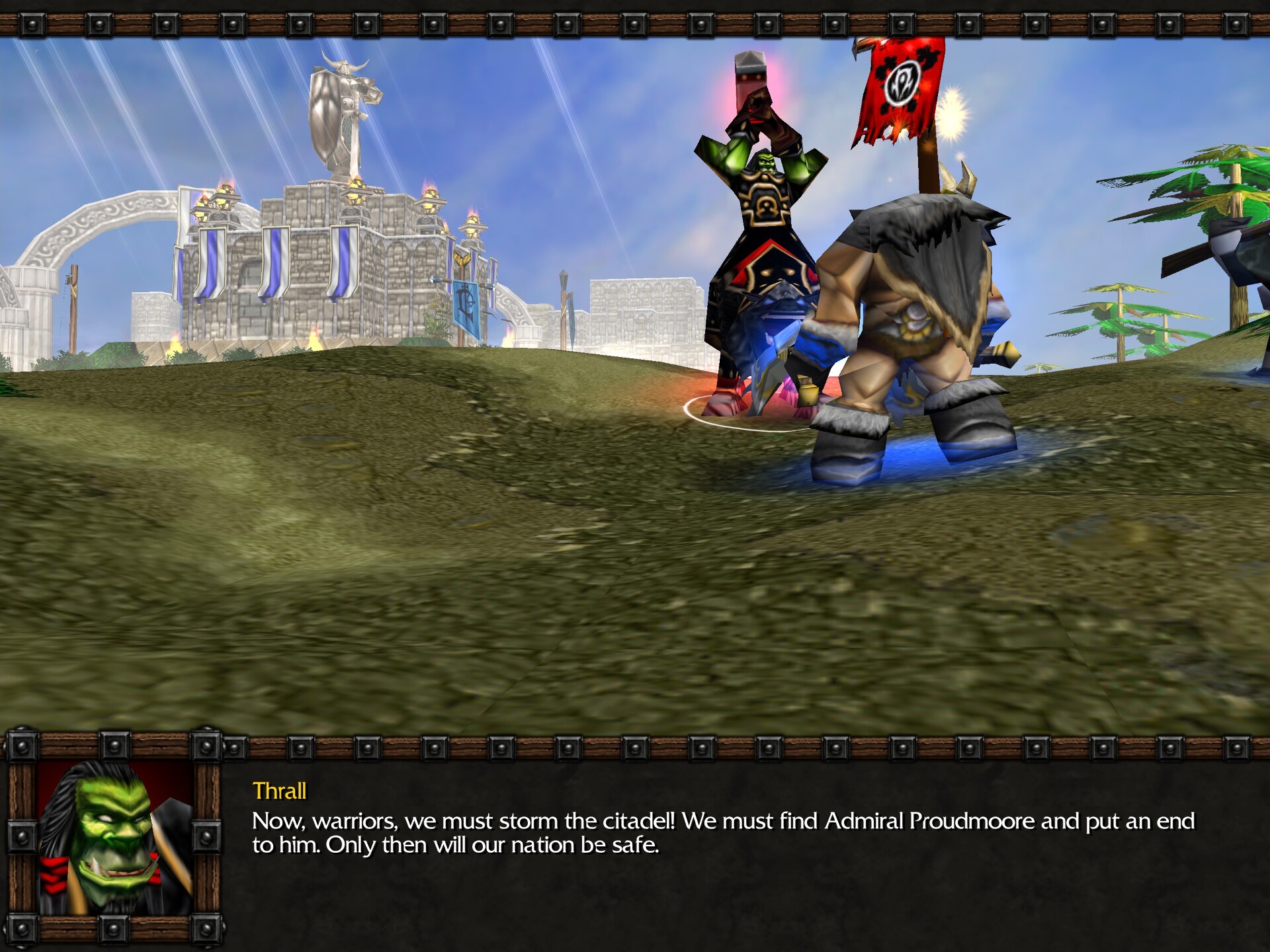
This final map is built and plays somewhat like a MOBA. We begin in the southwestern corner, and there are three lanes protected by towers: one middle one and two corner ones. As usual, we control just the heroes, while Horde and Kul Tiras troops spawn and engage each other automatically. We clear the towers and enemy resistance to allow our allies to proceed all the way to Admiral Proudmoore’s throne room.
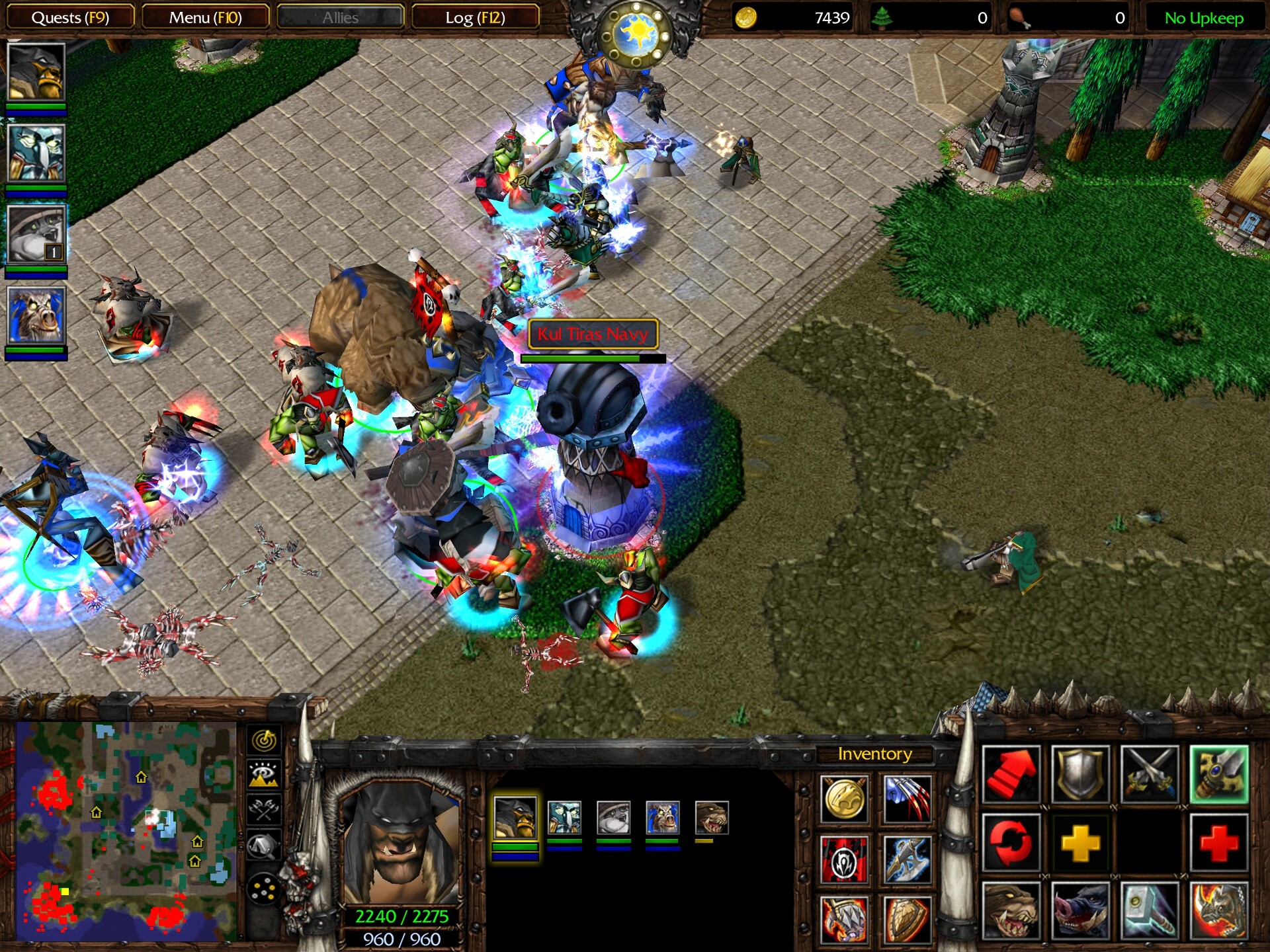
The admiral himself is protected by elite troops, including a paladin and an archmage, and gets chatty as we approach.
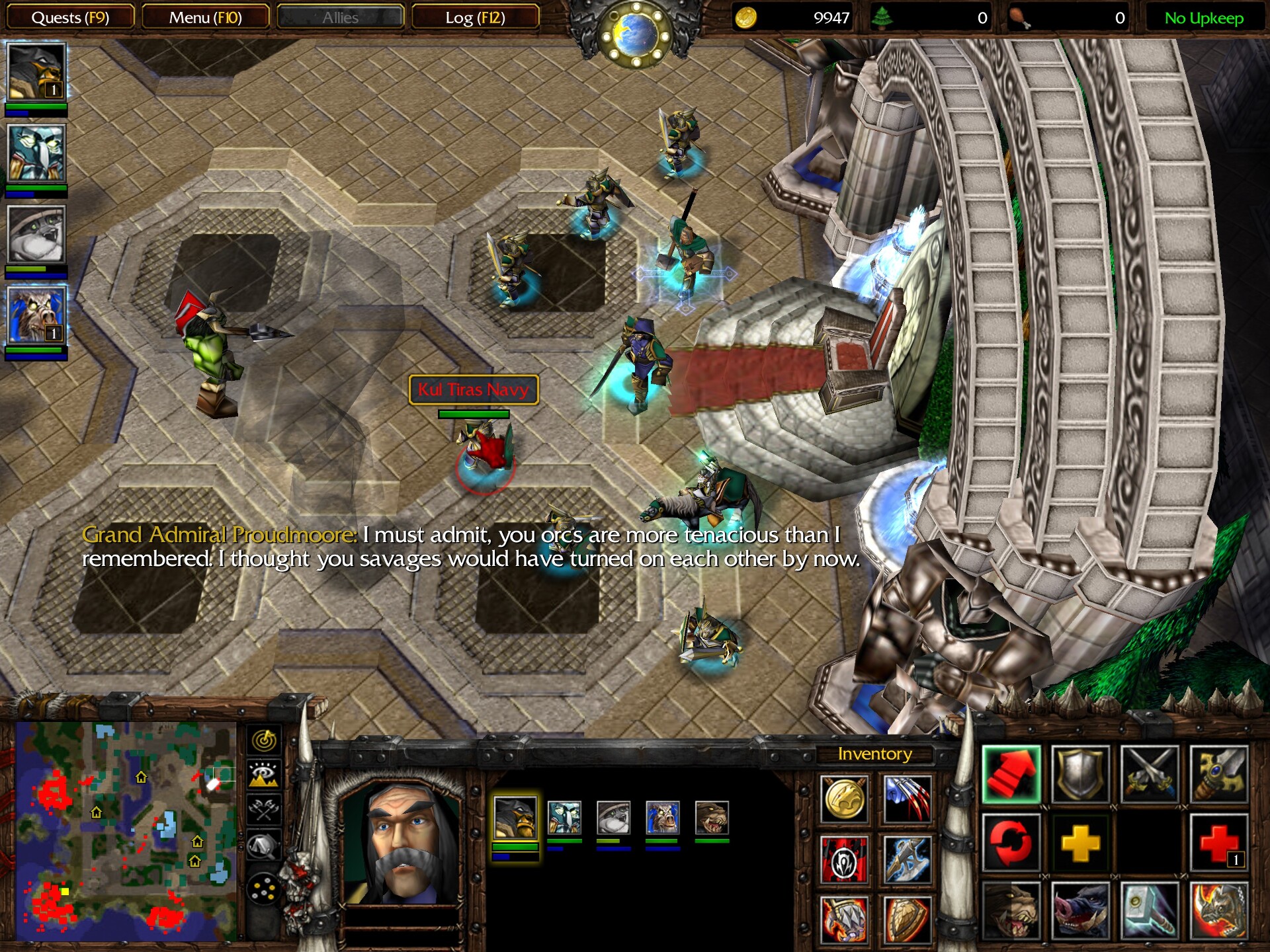
Somehow, he manages to get in conversation with Thrall, who is nowhere near the throne room.
Grand Admiral Proudmoore: I must admit, you orcs are more tenacious than I remembered. I thought you savages would have turned on each other by now.
Thrall: This is not the Horde you remember, old man. We have no interest in conquest or murder. We have paid for our sins of our forebears in blood.
Grand Admiral Proudmoore: Can your blood atone for genocide, orc? Your Horde killed countless innocents with its rampage across Stormwind and Lordaeron. Do you really think you can just sweep all that away and cast aside your guilt so easily? No, your kind will never change, and I will never stop fighting you.
I like this. Admiral Proudmoore has lived through the events of Warcraft 2 and remembers the atrocities of Doomhammer’s Horde. Even if the orcs are reformed now, and Proudmoore is absolutely a menace who needs to be stopped, he does have a point: saying that we’re all friends now isn’t going to cut it to the victims of the old Horde’s rampage. Much, much later, Blizzard will compose a song about the events of this campaign written from the perspective of the Kul Tirans, highlighting how one side’s villain was the other side’s hero.
With their leader’s death, the men stand down. They won’t bother the fledging new Horde any more.5
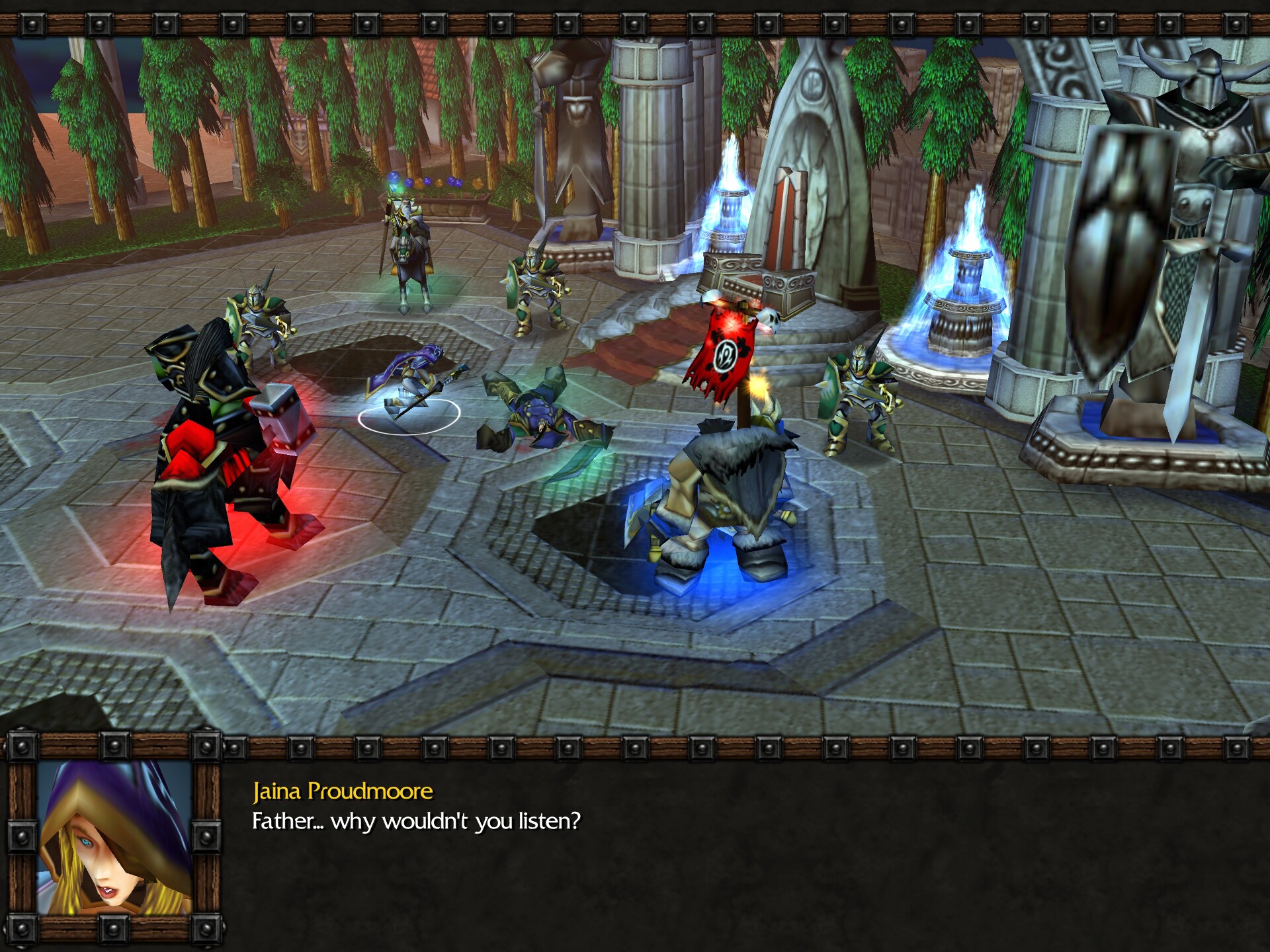
Rexxar tells Jaina that, above all, he was a proud warrior, and she should remember him as such — though I’m not sure it’s much of a consolation. Durotar is now safe, and the Horde, having no further quarrel with the humans, withdraws.
Thrall offers Rexxar to return to Durotar with him and make a new home for himself, but he respectfully declines.
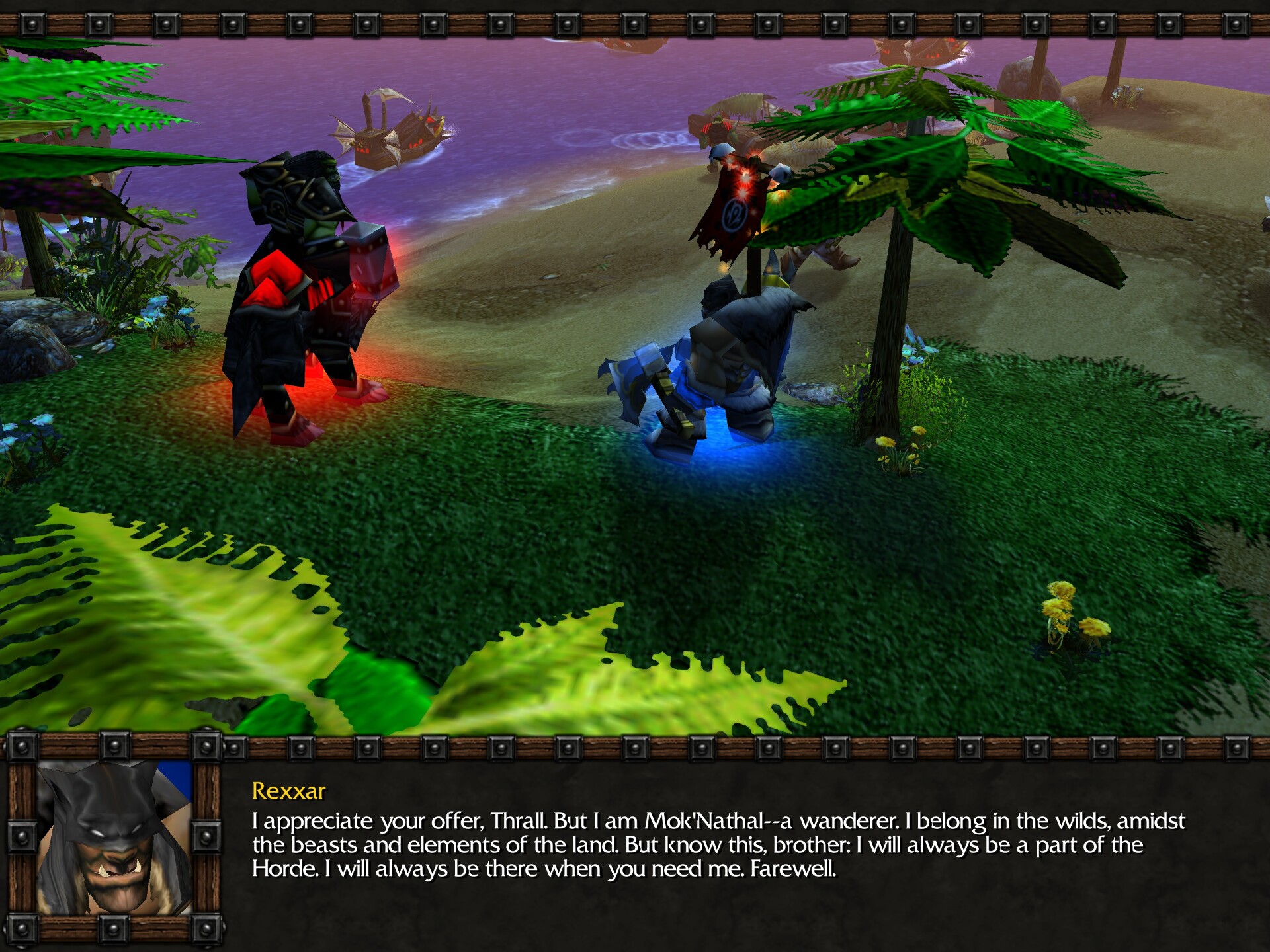
And that’s the end of Warcraft 3’s experimental RPG campaign. There will be more adventures on the horizon, more quests, more earth-shattering revelations, and even a full-scale war — but not in this game. A year later, World of Warcraft will be released, and will take the world by storm.
Final Thoughts
And that was Warcraft 3: The Frozen Throne.
The Founding of Durotar is one of my favorite campaigns in the entire game. It’s fun, easy, empowering, daringly experimental, and not too long; sort of a “mini-WoW” made on the Warcraft 3 engine. Its themes are settling the frontier and overcoming old hatreds, both perfectly fitting the tone of Warcraft 3. This campaign has served as inspiration for map makers to come, to push the World Editor to its limits. It further develops Kalimdor and the Horde, setting up the state in which we find them in the Warcraft RPG and in WoW. Rexxar has had enduring popularity since his introduction, even becoming the default hunter hero in Hearthstone.
And looking back at Warcraft 3 as a whole, both Reign of Chaos and The Frozen Throne, I can’t help but notice a pattern.
Before Warcraft 3, Blizzard made Starcraft. That game pioneered many of the gameplay and story elements that were later used in Warcraft 3: the sides (terrans, protoss, and zerg) now had wildly different gameplay instead of being cosmetic mirrors of each other, movable buildings were introduced, as well as a special type of ground (creep) that was required for one side to generate to place their buildings on, and so on and so forth. Story-wise, the campaigns no longer took place in parallel universes with mutually exclusive outcomes, but formed a single storyline when played in sequence; mission exposition was done via talking heads, and there were scripted events and character banter occurring during the missions themselves.
The basic structure of the narrative that Starcraft pioneered was later reused in Reign of Chaos:
- First is the human campaign, where an all-consuming swarm (zerg/undead) encroaches on human lands (the Confederacy/Lordaeron), culminating with the fall of the capital, and one human hero (Arthas/Kerrigan) is corrupted and joins the swarm.
- In the second campaign, the swarm expands its influence while the corrupted human hero is constrained by the need to serve the mastermind behind the swarm (the Overmind/Archimonde).
- Finally, we play as a proud ancient race (protoss/night elves) that eventually stops the swarm by killing the mastermind in a climactic last stand.
Now, TFT is less overtly derivative of Starcraft’s expansion Brood War, but there are some parallels there too:
- In the first campaign, we play as the same side as the final campaign of the original game (protoss/night elves), dealing with the fallout from the events of the original game.
- A new human force emerges and is initially successful in turning the tide (the UED/Garithos’s forces).
- In the last campaign, we once again play as the swarm, as its corrupted leader (Kerrigan/Arthas) cements their power, setting them up as an antagonist for the next game.
And while the expansion orc campaign is separate from everything else, Admiral Proudmoore reminds me of DuGalle, as the leader of a new human armada that suddenly shows up and disrupts the status quo; they even both die at the ends of their stories.
It’s not a perfect match, especially for the expansion. The orcs don’t fit neatly into this basic story framework. In Reign of Chaos, they were largely doing their own thing, not fighting the Scourge; in The Frozen Throne, their campaign is separate from the rest. Arthas took every step of his journey willingly, but Kerrigan’s infestation was forced on her, and a closer parallel to her story role would be Sylvanas, who was similarly raised into undead against her will and remained evil (and treacherous) even after getting her free will back.
And you know what? I don’t really mind.
The Warcraft 3 story isn’t deep, and the characters are all basic and larger than life. But it feels like exactly the right amount of story for the kind of game it’s written for — an RTS with comic book aesthetics. It has just enough meat on it to be told primarily via in-game cutscenes. Any less story, and the missions would feel pointless; any more, and the cutscenes would overstay their welcome. Sure, it’s troperiffic, but tropes are not bad, and Warcraft 3 puts enough of an original spin on fantasy tropes to look fresh and original rather than derivative. It helps that there are more factions in the world than just the four playable ones, and reshuffling them keeps things interesting.
World of Warcraft may have become the defining work set in the Warcraft setting, eventually pulling everything else to revolve around it, but Warcraft 3, back in the day, served as the solid foundation of the setting; with its new lands, plots, and characters, it formed the Warcraft we know and love to this day, and became the gold standard for “that Warcraft feel”.
Next Up
Now that we’re done with all three Warcraft RTS games and all their expansions, we’re finally ready to answer a question raised way back at the beginning: what does it mean for a work to “feel like Warcraft”? And what do we mean when we say that a work isn’t the Warcraft we know and love, that it doesn’t have the right feel?
We’ll tackle this question next time.
They came from… behind!
-
An orc transport ship that was conveniently placed near two human battleships. Somehow. ↩
-
I think it’s five. I’ve lost count. ↩
-
Spirit walkers are a new tauren support unit added in the expansion. ↩
-
Orgrim too. To Thrall, he was a mentor, and he named his capital city, Orgrimmar, in Doomhammer’s honor. To the people of the Alliance, he was a ruthless conqueror who nearly brought the whole continent to its knees. ↩
-
Or will they? Dun dun duuun! ↩
Leave a Comment